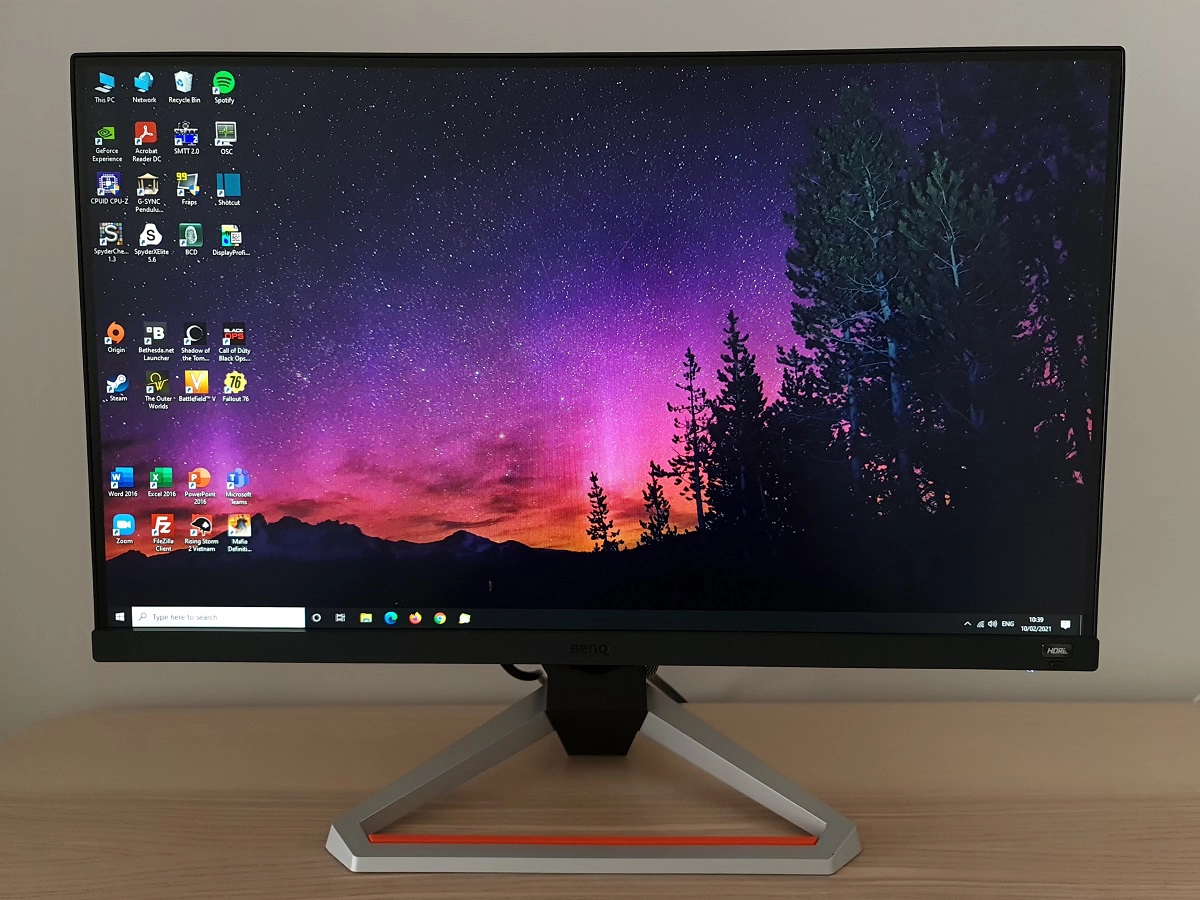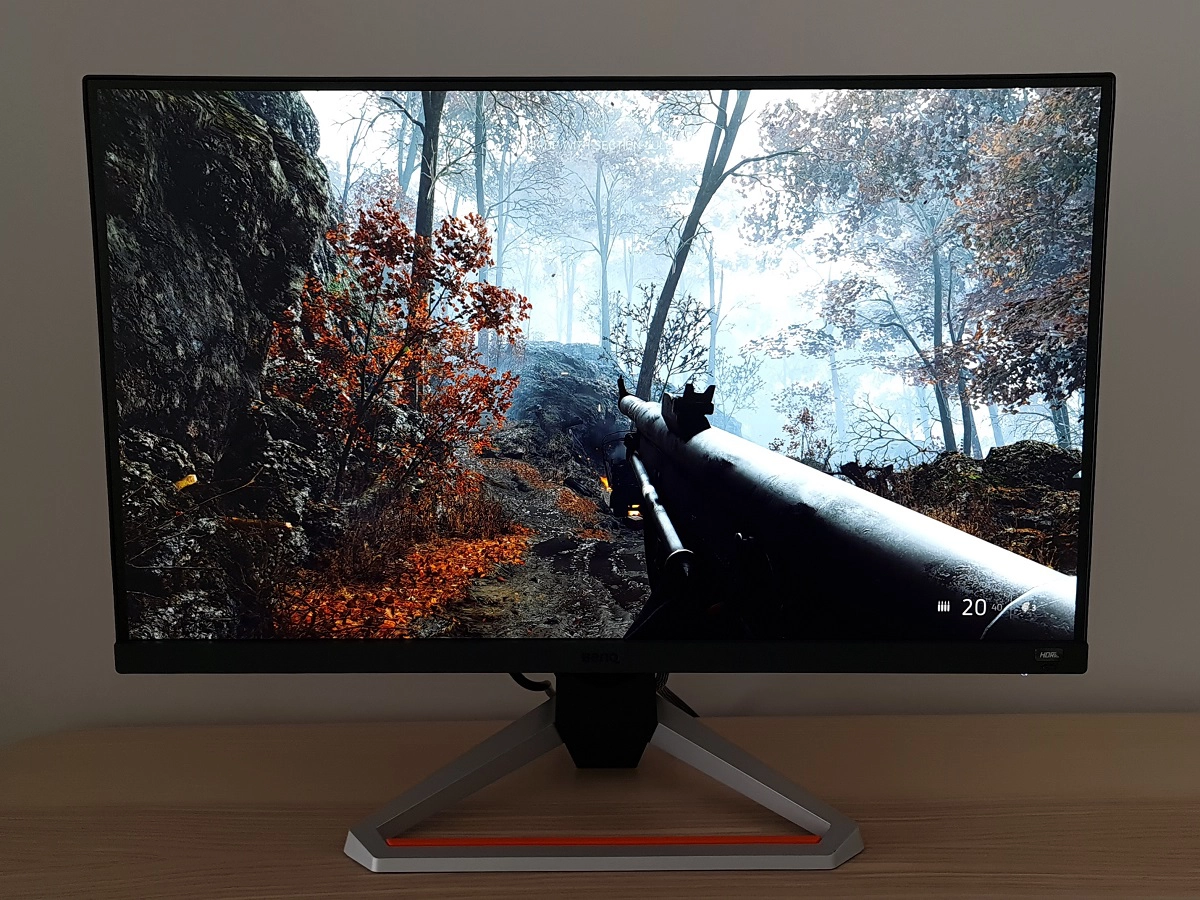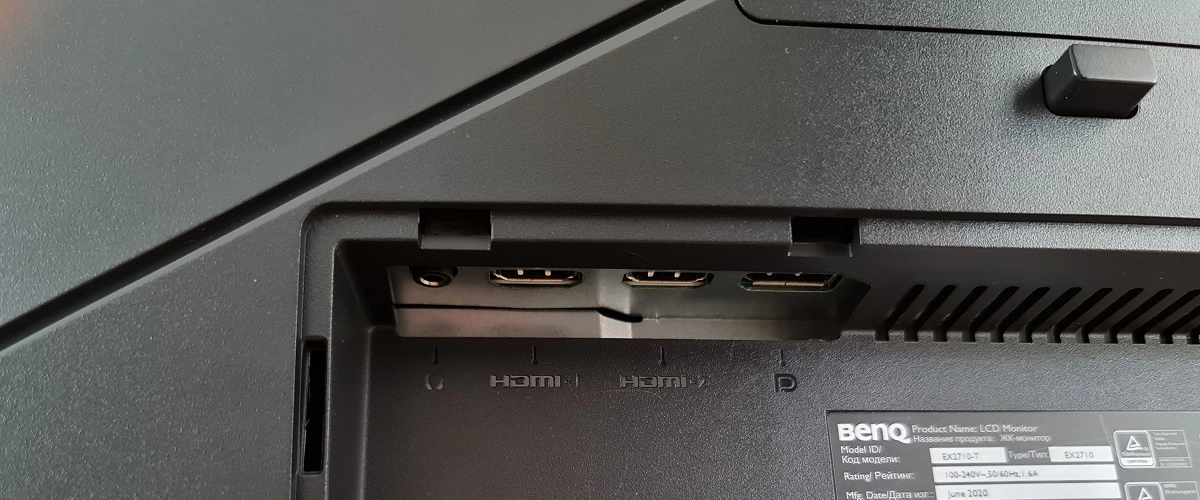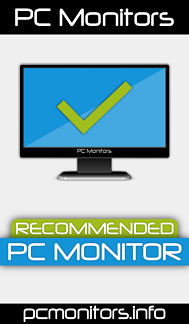Author: Adam Simmons
Date published: February 22nd 2021
Table of Contents
Introduction
High refresh rate IPS-type (In-Plane Switching and similar) models are popular amongst gamers looking for a responsive and colour-rich experience. The BenQ EX2710 of the MOBIUZ series is one such offering, with features such as Adaptive-Sync – including AMD FreeSync Premium – and a 144Hz refresh rate. As a 27” model it aims to provide some extra immersion to the experience compared to smaller screens, but it sticks to the easy to drive Full HD resolution. It also includes a range of gaming-oriented features and other enhancements such as ‘Light Tuner’, ‘Black eQualizer’ and ‘HDRi’. It’s aimed at both PC gamers and console gamers with compatible systems who value high frame rates and performance over higher resolutions. We put this monitor thought its paces in our usual set of tests.
Note: The EX2710S is very similar to the base model reviewed here with a boost in maximum refresh rate from 144Hz to 165Hz.
Specifications
The monitor uses a 27” AU Optronics AHVA (Advanced Hyper-Viewing Angle) IPS-type panel. It supports true 8-bit colour and offers a 1920 x 1080 (Full HD) resolution, alongside a 144Hz refresh rate (165Hz for ‘S’ variant). A 1ms MPRT (Moving Picture Response Time) is specified using the included strobe backlight setting, alongside a 3ms grey to grey response. As usual, pay little attention to such figures. Some of the key ‘talking points’ for this monitor have been highlighted in blue below, for your reading convenience.
The monitor has what we’d broadly classify as a ‘gamery’ aesethetic. It has quite a unique look, with the stand base being quite a standout feature here. It has a silver plastic base element with a bright orange rubber strip on the inside of the frontmost section. This isn’t removable, but we didn’t it eye-catching or annoying when using the monitor normally. We largely forgot it was even there, in fact, so think of it as a MOBIUZ signature which identifies the monitor series rather than a source of annoyance. The bottom bezel is dark grey matte plastic, ~20mm (0.79 inches), with a small central glossy black BenQ logo. Plus an additional ~16.5mm (0.65 inches) underhang for the central sensor suite, which includes the light sensor used for the ‘B.I.+’ (Brightness Intelligence +) and HDRi features. A dedicated HDRi button is found towards the right side, with a silver-coloured label above which has a similar visual texture to a vinyl record, but lighter in colour. The top and side bezels are dual-stage, including a slim panel border that’s flush with the rest of the screen and a slender hard plastic outer component. Including both elements, the bezels are ~6.5mm (0.26 inches) at the top and ~7.5mm (0.30 inches) at the sides. The screen is the dominant feature from the front, with a light matte anti-glare finish that we explore a bit later. The OSD (On Screen Display) is controlled by a joystick at the rear, with a dedicated power button below it and source select button above it. This is located towards the bottom right of the monitor as viewed from the front. There’s also a dedicated HDRi button towards the right side of the bottom bezel, facing forwards, as noted earlier. Below and slightly to the left of this there’s an underhanging power LED, which glows a gentle cool white when the monitor is on and orange when it enters a low power state (signal to the system is lost). The following video runs through the menu system and explores its various features, including B.I.+. The ‘S’ variant also includes a ‘Sharpness’ control as illustrated in the manual (PDF), whereas the original variant shown in the video doesn’t include this. The monitor includes 2 x 2.5W treVolo speakers, down-firing at the bottom of the monitor. These are a good step above most integrated monitor speakers, offering superior depth and clarity. They won’t rival a decent standalone speaker set or good set of headphones, they lack directionality and aren’t particularly ‘bassy’. But they’re certainly quite useable and you wouldn’t be embarrassed for others around you to hear the sound they produce. Disclaimer: this naturally depends on the sound being played ; ). There are 3 ‘Audio Mode’ settings in the ‘Audio’ section of the OSD; ‘Game’, ‘Cinema’ and ‘Pop/live’. We generally found ‘Pop/live’ the best-balanced in most circumstances, although ‘Cinema’ can add a bit more a bass-heavy experience. Because there’s no subwoofer and these speakers aren’t overly powerful, it can also make things appear somewhat distorted without providing thumping bass. The ‘Game’ setting tends to sound quite hollow and tinny, whilst the directionality just isn’t there from 2 down-firing speakers anyway. The image below is a macro photograph taken on Notepad with ClearType disabled. The letters ‘PCM’ are typed out to help highlight any potential text rendering issues related to unusual subpixel structure, whilst the white space more clearly shows the actual subpixel layout alongside a rough indication of screen surface. This model uses a light matte anti-glare screen surface with a relatively smooth surface texture. This surface offers relatively good glare handling, avoiding the sort of distinct reflections you’d see on a glossy or much lighter screen surface. It also preserves clarity and vibrancy better than ‘stronger’ matte screen surfaces. It offers more direct emission of light with lower diffusion, giving it less of a layered appearance in comparison. When observing lighter shades there was a light misty graininess rather than a heavy or ‘smeary’ graininess. This surface is slightly lighter and has a somewhat smoother surface texture than the 24.5” models, such as the EX2510 and XB253Q GP. The BenQ EX2710 offers a range of ‘Color Mode’ presets; ‘HDR’, ‘Game HDRi’, ‘Cinema HDRi’, ‘FPS’, ‘RPG’, ‘Racing Game’, ‘Standard’, ‘M-Book’ and ‘ePaper’. The first three presets, with HDR in them, are the only presets selectable under HDR (High Dynamic Range). But can also be selected under SDR (Standard Dynamic Range) where various adjustments are made to the image – think of them as a sort of ‘filter’, but there’s nothing ‘HDR’ about the resulting image with an SDR signal. We touch upon these presets in the OSD video and explore some of them elsewhere in the review. For this section we’ll instead focus on manual adjustments that can be made in the OSD. The table below includes gamma and white point readings taken using a Datacolor SpyderX Elite colorimeter. General observations made by eye are also provided. Our test system uses Windows 10 and an Nvidia RTX 3090 connected using a DP cable. Additional testing was performed with an AMD Radeon RX 580 and using HDMI, although for the purposes of this table that had no impact. An additional step should be performed in the graphics driver if connected to an Nvidia GPU via DP and set to 120Hz or below (i.e. a refresh rate from the ‘Ultra HD, HD, SD’ list, shown earlier). The colour signal should be corrected to a ‘Full Range RGB’ signal as detailed in this article. Interestingly, the monitor used the correct Full Range RGB signal by default via HDMI regardless of refresh rate. And it handled the limited Range RGB signal a lot better than many screens, under SDR at least, without completely washing out the image. Note that no additional monitor drivers or ICC profiles were specifically loaded. The monitor was left to run for over 2 hours before readings were taken or observations made. Aside from our ‘Test Settings’ where various adjustments are made, assume factory defaults are used with the monitor running at 144Hz. Adjusting the refresh rate did not affect the static image quality of readings for this table, however. We also set ‘Input’ – ‘Scenario’ to ‘Off’, so the default preset used for our testing became ‘Standard’ rather than ‘RPG’. When viewing the figures in this table, note that for most PC users ‘6500K’ for white point and ‘2.2’ for gamma are good targets to aim for. Individual targets depend on individual uses, tastes and the lighting environment, however.
*10-bit can be selected in the graphics driver when using DP at any refresh rate, up to the native resolution. 10-bit and 12-bit can be selected when using HDMI up to the native resolution at up to 120Hz. Confusingly, 12-bit but not 10-bit is available at 144Hz via HDMI. The panel used is only an 8-bit panel, but the monitor’s scaler can add a dithering stage to facilitate work with higher bit depth content.
As an Amazon Associate I earn from qualifying purchases made using the below link. Where possible, you’ll be redirected to your nearest store. Further information on supporting our work.
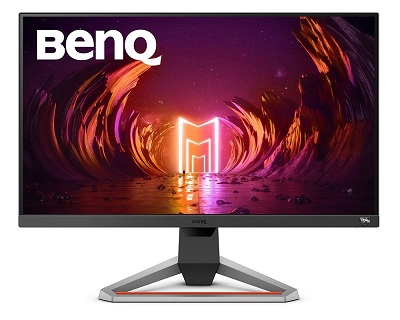
Features and aesthetics
Note that any interlaced lines in the images below with monitor switched on are moiré from the camera, not from the monitor itself.
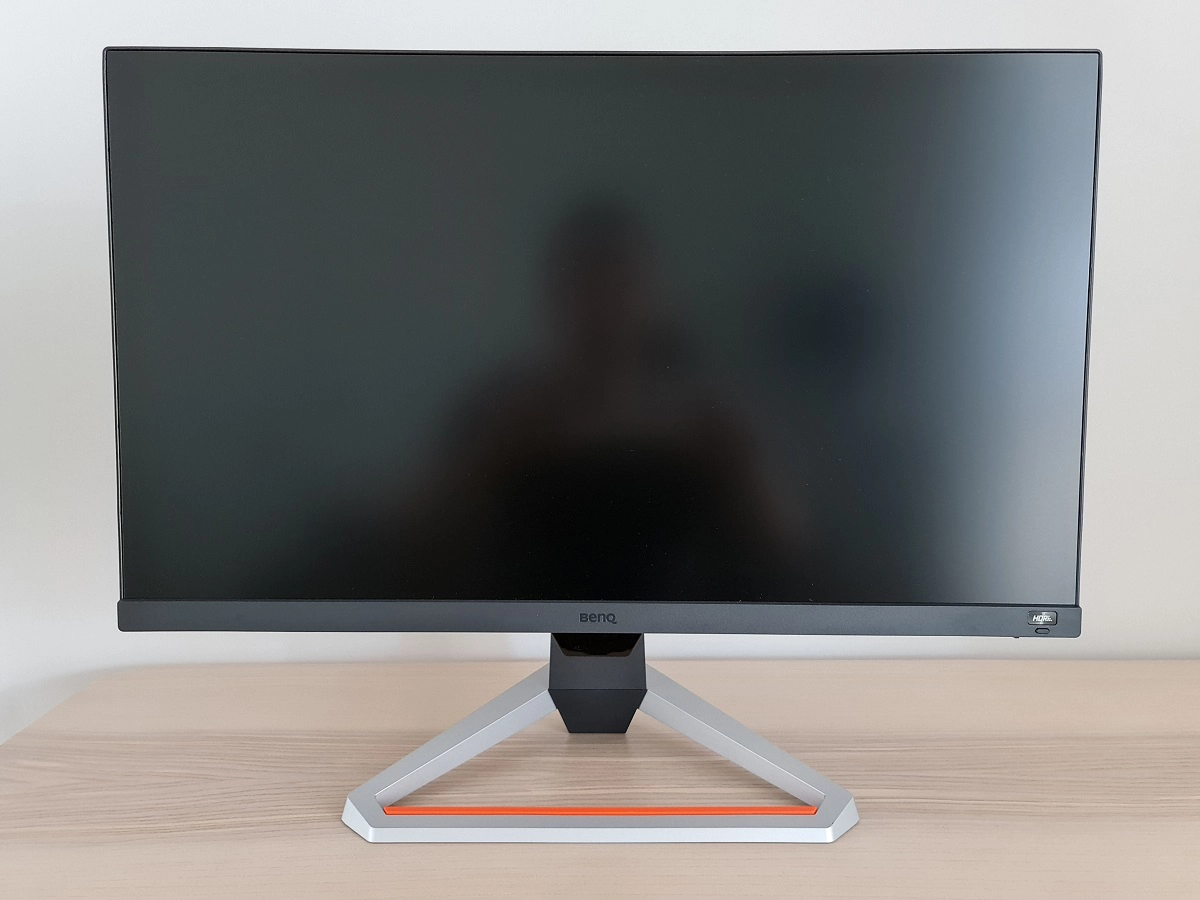
The monitor is quite slender at the side, ~20mm (0.79 inches) at thinnest point but bulking out a bit more centrally towards the stand attachment point. The stand offers good ergonomics; tilt (5° forwards, 20° backwards), swivel (20° left, 20° right) and height adjustment (130mm or 5.12 inches). At lowest stand height the bottom of the monitor clears the desk by ~48mm (1.89 inches) or ~31.5mm (1.24 inches) including the sensor unit. The top of the screen sits ~412mm (16.22 inches) above the desk. The total depth of the monitor including stand is ~220mm (8.66 inches) with the screen a few cm back from the front edge of the stand. So a reasonably compact design overall, especially compared to some gaming monitors with quite ostentatious and unnecessarily deep stand designs.

The rear of the monitor is mainly matte black plastic, visually split into 4 triangular sections separated by slender black glossy plastic bands. There’s glossy black MOBIUZ logo at the top. The stand attaches centrally using a quick-release mechanism, quickly detached from the screen by pressing a button below the attachment point. This reveals 100 x 100mm VESA holes for alternative mounting. There’s a rectangular cable-tidy hole towards the bottom of the stand neck. The OSD controls are found towards the bottom left, whilst there’s a K-Slot towards the bottom right. In the middle, facing downwards beneath a removable plastic cover, you’ll find the ports; a 3.5mm headphone jack, 2 HDMI 2.0 ports, DP 1.2a+ (HDR feature set) and an AC power input (internal power converter).
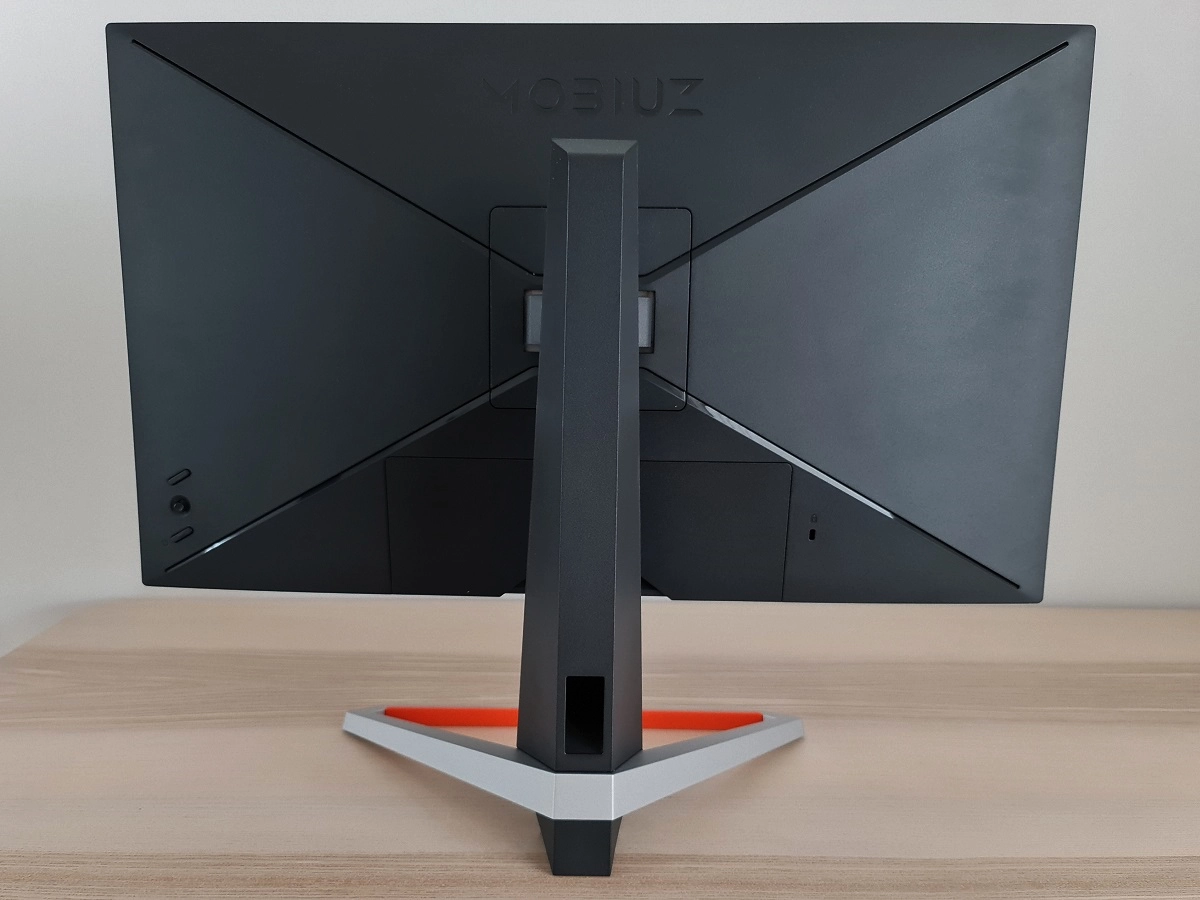

The full capability of the monitor including 1920 x 1080 @144Hz plus HDR and Adaptive-Sync can be leveraged using DP 1.2a+ and HDMI 2.0. Suitable DisplayPort versions support Nvidia’s ‘G-SYNC Compatible Mode’ and AMD FreeSync, whilst suitable versions of HDMI only support AMD FreeSync. A power cable is included as standard, but additional accessories depend on region and retailer. The first and second images below show the refresh rates supported by the monitor, identical via both DP and HDMI. The third image shows a ‘4k x 2k, 3840 x 2160’ downsampling mode which is included when using HDMI. A range of other downsampling settings are also available with the same refresh rates listed, including 2560 x 1440. These settings are potentially useful for games consoles that accept a 3840 x 2160 signal, which certainly isn’t the same as viewing content on a native ‘4K’ UHD monitor but can still enhance image quality.
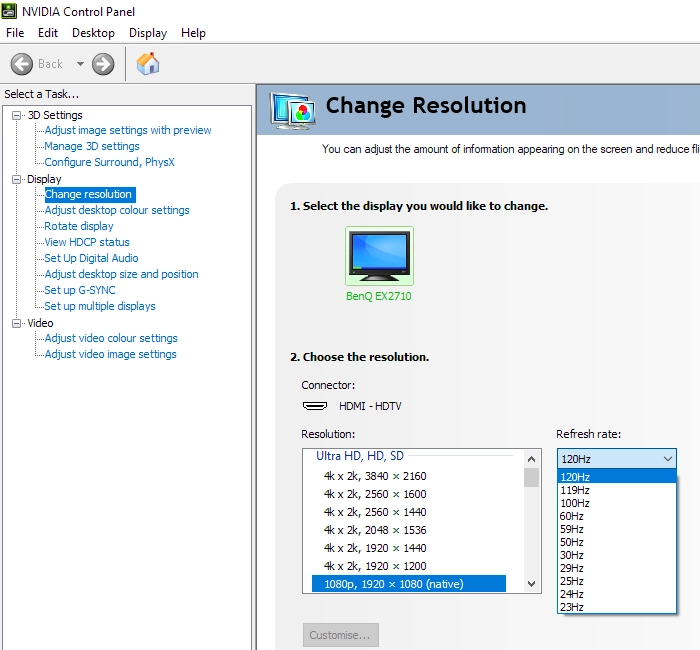
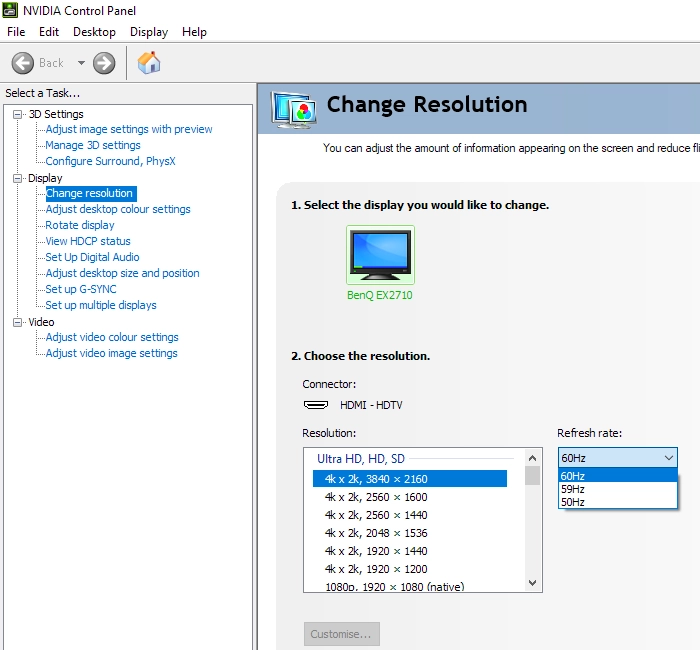
If you’re intending to use the monitor with the PS5 or Xbox Series X/S, be aware that a small settings tweak may be required to ensure 120Hz is selectable for the Full HD resolution. Details can be found in this article.
Calibration
Subpixel layout and screen surface
![]()
As illustrated above the standard RGB (Red, Green and Blue) stripe subpixel layout is used. This is the default expected by modern operating systems such as Microsoft Windows. Apple’s MacOS no longer uses subpixel rendering and therefore doesn’t optimise text for one particular subpixel layout to the detriment of another. You needn’t worry about text fringing from non-standard subpixel layouts and won’t need to change the defaults in the ‘ClearType Text Tuner’ as a Windows user. You may still wish to run through the ClearType wizard and adjust according to preferences, however. The subpixel layout and arrangement is normal and we had no subpixel-related concerns related to sharpness or text clarity on this model.
Testing the presets
Preset Mode Gamma (central average) White point (kelvins) Notes Standard (Gamma = 3) 2.3 6721K A look we like to describe as ‘rich and natural’, with a somewhat cool tint. A touch of extra depth and saturation for sRGB content due to the gamma handling and gamut, nothing dramatic. Gamma = 1 1.9 6758K As above but a significant reduction in depth and less saturated overall due to significant gamma reduction gamma. Gamma = 2 2.1 6787K As above, superior depth and some extra saturation due to gamma increase. Still not quite enough depth in places. Gamma = 4 2.5 6764K As factory defaults with quite a bit of extra depth. Quite a cinematic look, a clear lack of distinction amongst darker shades. Gamma = 5 2.7 6780K As above but even more depth, a very striking but inaccurate representation. sRGB 2.3 6568K An sRGB emulation setting, restricting colour gamut so it runs even closer to sRGB. Brightness can be adjusted, other settings including gamma and colour channels can’t. Things appear somewhat more muted, actually a bit undersaturated in places with a slightly weak green channel. Low Blue Light = 10 2.3 5136K A moderately effective Low Blue Light (LBL) setting. Provides a warmer look to the image with a modest reduction in the blue channel compared to default. No clear green or yellow tint introduced, visually better balanced than many LBL implementations. Low Blue Light = 20 2.3 4017K As above but significantly stronger effect. A highly effective LBL setting, significantly reducing blue light output. A warmer look to things but still no unwanted green or yellow tint. Color Temperature = User Define 2.3 6379K As factory defaults but somewhat warmer look, a touch brighter and with a bit of a green bias. All colour channels are in their neutral position (‘100’), maximising contrast. Test Settings 2.3 6515K A rich and natural appearance, with good variety and overall balance.
Out of the box the monitor provided an image that is rich and natural, with a somewhat cool tint. This was easily correctable via the OSD. The gamma tracked a bit above ‘2.2’, averaging ‘2.3’ – there are alternative gamma modes on the screen, but none matched ‘2.2’ exactly on our unit. And we found the overall balance best using the default setting. The gamma curve for our ‘Test Settings’ (similar to factory defaults in this respect) is shown below. There’s a bit of bowing to the curve centrally, but the deviation is far from extreme and didn’t necessitate further intervention. Given the intended uses for the monitor, inter-unit variation and reasonable performance following OSD tweaking alone we will not be using any ICC profiles in this review or including any measurements or graphs using them. We wouldn’t recommend using them unless created for your specific unit using your own calibration device. But we appreciate some users still like to use profiles and some aspects such as gamut mapping for colour-aware applications can be useful. You can download our ICC profile for this model, which was created using our ‘Test Settings’ as a base. You can also download our sRGB profile, created using ‘Color Mode = sRGB’ (sRGB emulation mode). Amongst other things, this profile corrected gamma from ‘2.3’ to ‘2.2’ on our unit – but be aware of inter-unit variation. And note again that these ICC profiles are not used in the review. The monitor includes a range of easily accessible Low Blue Light (LBL) settings, which can be set between ‘0’ (disabled) and ‘20’ (strongest effect). The stronger settings were particularly effective at reducing blue light output from the monitor, especially when coupled with reduced brightness. They significantly reduced the blue colour channel and hence blue light output from the monitor. They also strengthen the red channel whilst reducing the green channel somewhat, providing a better visual balance compared to some LBL settings which can introduce a green or yellow tint. This has an effect on contrast as we explore shortly. The image appeared warmer using these settings, which we found our eyes adjusted to quite readily over time – more so than when additional imbalances such as a green tint are introduced. Reducing blue light exposure is particularly important in the hours leading up to sleep as blue light is stimulating to the body and affects sleep hormones. It increases alertness and makes it more difficult to ‘shut off’. We used the strongest setting of ‘20’ over our ‘Test Settings’ for our own viewing comfort in the evenings. But not for any specific testing beyond that involving the setting itself. Our ‘Test Settings’ involved a significant reduction in brightness and slight colour channel adjustments. Note that individual preferences and units of the same model vary, so these settings should just be considered a suggestion. They aren’t going to be optimal for all users. We’ve also included our preferred ‘AMA’ setting and the refresh rate used in Windows, just for reference. HDR has separate settings associated with it and is explored in the relevant section of the review – our preference there was to set ‘HDR Mode’ to ‘Display HDR’ with full brightness. Color Mode= Standard Brightness= 38 (according to preferences and lighting) Color Temperature= User Define R= 99 G= 97 B= 100 AMA= 1 Refresh rate (Windows setting)= 144Hz We used an X-Rite i1Display Pro to measure white and black luminance levels, from which static contrast ratios could be calculated. The table below shows this data, with various settings used. Assume any setting not mentioned was left at default, except for the changes already noted in the calibration section. Note that ‘Blur Reduction’ was also tested at 120Hz and 100Hz, but this had no significant impact on brightness or contrast. Black highlights indicate the highest white luminance, lowest black luminance and maximum contrast ratio recorded (Blur Reduction and HDR disabled). Blue highlights indicate the results with HDR active and under our ‘Test Settings’.
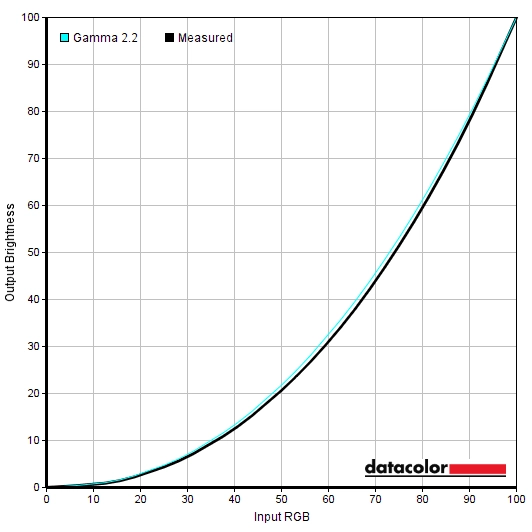
Gamma 'Test Settings'
Test Settings
Contrast and brightness
Contrast ratios
Monitor Settings White luminance (cd/m²) Black luminance (cd/m²) Contrast ratio (x:1) 100% brightness 302 0.28 1079 80% brightness 254 0.24 1058 60% brightness 207 0.19 1089 40% brightness 158 0.15 1053 20% brightness 107 0.10 1070 0% brightness 56 0.05 1120 75% brightness (Factory Defaults) 245 0.23 1065 HDR Mode = Game HDRi (very bright room)* 485 0.42 1155 HDR Mode = Game HDRi (moderately bright room)* 395 0.34 1162 HDR Mode = Game HDRi (dark room)* 295 0.25 1180 HDR Mode = Cinema HDRi (very bright room)* 485 0.42 1155 HDR Mode = Cinema HDRi (moderately bright room)* 395 0.34 1162 HDR Mode = Cinema HDRi (dark room)* 296 0.25 1184 HDR Mode = HDR (100% brightness)* 486 0.41 1185 HDR Mode = HDR (50% brightness)* 279 0.24 1163 HDR Mode = HDR (0% brightness)* 57 0.05 1140 Gamma = 1 243 0.23 1057 Gamma = 2 243 0.23 1057 Gamma = 4 242 0.23 1052 Gamma = 5 244 0.23 1061 sRGB 241 0.23 1048 Low Blue Light = 10 207 0.23 900 Low Blue Light = 20 175 0.23 761 User (Color Temperature = User Define, 100% brightness) 342 0.28 1221 Blur Reduction (100% brightness) 202 0.19 1063 Blur Reduction (50% brightness) 113 0.11 1027 Blur Reduction (0% brightness) 17 <0.02 >850 Test Settings 163 0.14 1164
*HDR measurements were made using this YouTube HDR brightness test video, running full screen at ‘1080p HDR’ on Google Chrome. The maximum reading from the smallest patch size (measurement area) that comfortably covered the entire sensor area and colorimeter housing was used for the white luminance measurement, which was ‘4% of all pixels’ in this case. The black luminance was taken at the same point of the video with the colorimeter offset to the side of the white test patch, equidistant between the test patch and edge of the monitor bezel.
The average contrast ratio with only brightness adjusted was 1078:1, just slightly above the specified 1000:1 and fairly typical for an IPS-type model. The peak contrast recorded was 1221:1, with ‘Color Temperature = User Define) – this puts all colour channels in their neutral position to maximise contrast. We recorded 1164:1 under our ‘Test Settings’, which is respectable and beyond what some some IPS-type models will achieve. The lowest contrast recorded was 761:1, with ‘Low Blue Light = 20’ which is the strongest setting. As we noted earlier this makes changes to the colour channels which come at the expense of contrast, but with better balance to the image than many settings of this sort. The highest white luminance recorded under SDR was 342 cd/m², whilst the minimum white luminance recorded on the table (Blur Reduction disabled) was 56 cd/m². This gives a luminance adjustment range of 286 cd/m², with a reasonably low minimum and fairly bright maximum luminance.
The monitor offers no local dimming and therefore there was no contrast benefit under HDR. The peak luminance recorded was 486 cd/m² using the ‘HDR’ setting – quite bright, although not particularly impressive by HDR standards. Similar brightness (485 cd/m²) was recorded using ‘Game HDRi’ and ‘Cinema HDRi’ in a very bright room – these settings respond to the content of the screen but also the ambient lighting when making adjustments. Under these conditions, sunlight was streaming into the room freely and some of this was striking both the screen surface and sensor unit directly. The monitor brightness is raised as much as possible to try to compete with this. A lower but still reasonably bright luminance was recorded in a moderately bright room (395 cd/m²). Here, there was a good amount of natural light in the room but no strong direct light hitting the screen and sensor unit. In a dark room we recorded a dimmer 295 – 296 cd/m², which is still pretty bright. This was quite similar to the basic ‘HDR’ setting with brightness set to ‘50%’. Impressive bright highlights and bright shades are an important part of HDR, so we didn’t particularly like the idea of brightness being eaten away based on ambient lighting. We didn’t agree with the other adjustments made with the ‘HDRi’ setting either, as we explore later. But some will like the image they present and the overall HDR implementation on this model, although limited in capability, is at least flexible.
PWM (Pulse Width Modulation)
The EX2710 does not use PWM (Pulse Width Modulation) to regulate backlight brightness at any level. Instead, DC (Direct Current) is used to moderate brightness. The backlight is therefore considered ‘flicker-free’, which will come as welcome news to those sensitive to flickering or worried about side-effects from PWM usage. The exception to this is with Blur Reduction active, a strobe backlight setting which causes the backlight to flicker at a frequency matching the refresh rate of the display.
Luminance uniformity
Whilst observing a black background in a dark room, using our ‘Test Settings’, we noticed some backlight bleed and clouding. It’s important to note that individual units vary when it comes to all aspects of uniformity, including backlight bleed and clouding. The following image was taken a few metres back to eliminate ‘IPS glow’. This is a cool or warm grey glow (depending on angle) that appears towards the edges of the screen, particularly near the bottom corners from a normal viewing position. This ‘IPS glow’ blooms out more strongly from steeper angles, as demonstrated in the viewing angles video later. The luminance uniformity was not great overall, based on this particular assessment. The maximum luminance was recorded at ‘quadrant 5’ in the centre of the screen (160.3 cd/m²). The greatest deviation from this occurred at ‘quadrant 1’ towards the top left of the screen (134.0 cd/m², which is 16% dimmer). The average deviation between each quadrant and the brightest recorded point was 13.25%, which is moderate. However; ignoring the bright central region, the remaining quadrants were all within 6% of each other. This was visually less disturbing than having relatively dim and relatively bright patches dotted throughout the screen. Remember that individual units vary when it comes to uniformity and you can expect further deviation beyond the points measured. The contour map below shows these deviations graphically, with darker greys representing lower luminance (greater deviation from brightest point) than lighter greys. The percentage deviation between each quadrant and the brightest point recorded is also given. The SpyderX Elite was also used to analyse variation in the colour temperature (white point) for the same 9 quadrants. The deviation between each quadrant and the quadrant closest to the 6500K (D65) daylight white point target was analysed and a DeltaE value assigned. Darker shades are also used on this map to represent greater deviation from 6500K. A DeltaE >3 represents significant deviation that may be readily noticed by eye. Results here were good. Borderline significant deviation was recorded above the central region (DeltaE 3.0), with no significant deviation recorded elsewhere. This was based on deviation from the point to the right of centre, recorded as closest to 6500K in this test. Remember again that individual units vary when it comes to uniformity and that you can expect deviation beyond the measured points. On Battlefield V the monitor provided a reasonable contrast experience. The static contrast ratio certainly wasn’t sufficient to give impressive depth or an atmospheric look to darker content, particularly in a dimly lit room. It still edges out some IPS models in terms of its static contrast, at 1164:1 under our ‘Test Settings’. ‘IPS glow’ was also a feature, at quite a typical level for a 27” IPS-type panel. This ate away at the atmosphere and dark detail towards the bottom corners of the screen in particular, from a normal viewing position. This appeared silver-blue towards the bottom left and warm golden green towards the bottom right. The gamma consistency was strong, a key strength of IPS-type models like this. Which meant that detail levels were better maintained for dark content than on VA or TN models. These panel types show clear shifts in detail level depending on which part of the screen you’re observing. With a masking of detail centrally on VA models (‘black crush’) and potentially too much detail revealed peripherally. On TN models, perceived gamma is much too high towards the top of the screen, masking detail. And far too low further down the screen, giving a flooded or ‘blocky’ look with unintended detail. The light matte anti-glare screen surface with reasonably smooth finish kept things clear from obvious graininess. We made similar observations on Shadow of the Tomb Raider. This title demands a strong contrast performance to look its atmospheric best, with plenty of dimly lit caves and passageways illuminated by a few point sources of light. That isn’t what this model delivered, although it isn’t something we’d expect from an IPS-type panel either. And this model still edges out weaker IPS-type performers. ‘IPS glow’ was again a feature, particularly noticeable if the room is dim or moderately dim. The strong gamma consistency was a key strength, keeping dark detail more consistent without the clear shifts observed on VA and moreover TN models. The light matte screen surface with reasonably smooth finish helped with the representation of brighter shades, too. We also observed the film Star Wars: The Rise of Skywalker. As with Tomb Raider, there are plenty of high-contrast scenes here. With dimly lit backdrops illuminated by pulses of light such as flames, explosions and light sabers. The monitor didn’t provide a cinematic or atmospheric appearance here, particularly in dimmer room lighting. This is again due again to the static contrast and ‘IPS glow’. This film also has black bars at the top and bottom (letterboxing) due to the format of the film, which highlights these weaknesses quite readily. These black bars are typical for Hollywood film titles like this, but absent on most content on platforms such as Netflix where the 16:9 aspect ratio is more commonly targeted. The strengths in terms of relatively smooth screen surface and strong gamma consistency were again apparent on this title. The Lagom tests for contrast allow specific weaknesses in contrast performance to be identified. The following observations were made in a dark room. The colour gamut of the EX2710 (red triangle) was compared with the sRGB reference colour space (green triangle) using our ‘Test Settings’, as shown below. The monitor offers fairly comprehensive sRGB coverage (99%), with a very small amount of under-coverage. There’s a bit of overextension in the green to red region. Although not shown in the graphic, we measured 82% DCI-P3 and 77% Adobe RGB coverage. This isn’t sufficient to give HDR content the intended look, where strong DCI-P3 coverage is desirable and good coverage of the very wide Rec. 2020 gamut is aspirational. The measured gamut gives the monitor the potential to output most shades within the sRGB colour space, with just a touch of extra vibrancy. To maximise colour accuracy within the sRGB colour space, for colour-managed workflows, full calibration and profiling with a colorimeter or similar device is recommended. Although not needed in the same way it might on a true wide gamut display, the monitor offers an sRGB emulation setting which restricts the gamut slightly. This is activated by changing ‘Color Mode’ to ‘sRGB’. There is just a touch more under-coverage of sRGB now (98%), with overextension removed very effectively. This is close tracking of the sRGB colour space overall – and unlike some sRGB emulation modes, brightness can be adjusted. Although some other settings such as gamma and colour channels are locked off. To maximise colour accuracy within the sRGB colour space, for colour-managed workflows, full calibration and profiling with a colorimeter or similar device using the full native gamut is recommended. Instead of using this ‘sRGB’ setting and putting up with the associated restrictions, AMD users can activate a flexible sRGB emulation setting via the graphics driver. This is done by opening ‘AMD Radeon Software’, clicking ‘Settings’ (cog icon towards top right) and clicking on ‘Display’. You should then ensure that the ‘Custom Color’ slider to the right is set to ‘Enabled’ and ‘Color Temperature Control’ set to ‘Disabled’. It may appear to be set this way by default, but the native rather than restricted gamut is likely in play. If that’s the case, simply switch the ‘Color Temperature Control’ slider to ‘Enabled’ then back to ‘Disabled’ to leverage the sRGB emulation behaviour. This setting is shown in the image below. The gamut below shows results using our ‘Test Settings’ with this driver tweak applied. The colour gamut now covers 97% sRGB with a bit of extension beyond. The monitor’s sRGB emulation setting tracked closer to sRGB. But this driver tweak provides decent tracking of the sRGB gamut without profiling, including in applications that aren’t colour-managed. And you don’t have to put up with restrictions associated with the monitor’s sRGB emulation setting. Remember not to use this tweak under HDR, though, or the image will appear significantly oversaturated. On Battlefield V the monitor provided a rich and natural look to colours. As above, the monitor comprehensively covers the sRGB colour space with just a bit of extension beyond this. It doesn’t come close to covering DCI-P3 or Adobe RGB. This means that shades are reproduced quite faithfully, as the developers intended or just a touch more saturated in places. The extra vibrancy and saturation was certainly toned down compared to wide gamut models, which tend to make yellowish greens look far too yellow and reddish browns look far too red. On the BenQ, there was just a touch of extra yellowing in places, but there was a nice range of muted pastel greens alongside some fairly deep and lush green shades. Skin tones, woody tones and earthy tones appeared quite neutral as well, with a bit of an orange-red push but not the clear red push often observed with a wider gamut. There were some good licks of vibrancy in places, such as for brightly painted objects and roaring orange flames – not as eye-catching as on wide gamut models, but still vivid. The strong consistency of the IPS-type panel ensured this richness was maintained throughout the screen, without the sort of saturation changes you see peripherally on VA models or vertically on TN models. Shadow of Tomb Raider gave a similar look to things. Lara Croft’s skin looked quite appropriate with just a hint of extra tan to it, but she didn’t appear heavily tanned or potentially sunburnt. The natural environments showcased a good range of quite vivid but still natural-looking greens and rich earthy browns. Again, just a touch of extra yellowing for some yellowish green shades and a bit of an orange-red push to some reddish browns, but much less pronounced than on models with a colour gamut closer to DCI-P3. Vibrant elements such as bright orange berries, purple flowers and colourful painted artifacts appeared quite vivid, but again with saturation and a look that’s quite close to the developer’s intentions. The strong consistency again helped with the maintenance of this saturation throughout the screen. We made further observations using various episodes of the animated TV series Futurama. This series has large areas of individual shade and is therefore a particularly brutal test for colour consistency. The monitor performed well in that respect. There were some slight shifts for some shades, such as the red of Dr Zoidberg, but only minor and towards the very extreme edges. This isn’t unusual to see for IPS-type panels, with this one performing better than some IPS-types in that respect. There were no clear saturation shifts as you’d see on VA and moreover TN models. A good range of subtly different pastel shades were displayed, with an appropriately muted appearance overall. Bright and neon shades such as bright pink and green appeared fairly eye-catching, although not to the extent observed on models with a more generous gamut. Deep oranges, purples and dark greens were also represented well. The image below shows a printed reference sheet of 24 ‘sRGB’ shades, included as part of the Datacolor SpyderCHECKR 24 package. The screen is displaying reference photographs of this printed sheet, in both the same order as printed (right side) and reverse order (left side). The camera is mounted slightly above centre so that the image is representative of what the eye sees from an ergonomically correct viewing position. This, coupled with the inclusion of a flipped version of the shade sheet, allows both accuracy and colour consistency to be visually assessed. Bracketed numbers in our analysis refer to shades on the printed sheet or right side of the screen if they’re ordered consecutively from top left to bottom right. Note that there is always some disparity between how emissive objects (monitor) and non-emissive objects (printed sheet) appear. The representation of shades in this image depends on the camera and your own screen, it’s not designed to show exactly how the shades appear in person. It still helps demonstrate some of the relative differences between the original intended sRGB shade and what the monitor outputs, however. Full profiling and appropriate colour management on the application would provide a tighter match, our intention here is to show what can be expected in a non colour-managed environment. Lagom’s viewing angle tests help explore the idea of colour consistency and viewing angle performance. The following observations were made from a normal viewing position, eyes ~70cm from the screen. On some monitors, particularly but not exclusively thos¬e with high refresh rates, interlace patterns can be seen during certain transitions. We refer to these as ‘interlace pattern artifacts’ but some users refer to them as ‘inversion artifacts’ and others as ‘scan lines’. They may appear as an interference pattern, mesh or interlaced lines which break up a given shade into a darker and lighter version of what is intended. They often catch the eye due to their dynamic nature, on models where they manifest themselves in this way. Alternatively, static interlace patterns may be seen with some shades appearing as faint horizontal or vertical bands of a slightly lighter and slightly darker version of the intended shade. We did not observe any static interlace patterns on this model. Under certain conditions we observed some dynamic ‘interlace pattern artifacts’, fine interlaced vertical lines during movement or when scanning our eyes across the screen in a certain way. These were very faint at higher refresh rates such as 120Hz and 144Hz. At relatively low refresh rates (~60Hz for example) they were more noticeable, although didn’t jump out as much as they do on some models. They aren’t something most users would notice or find bothersome, especially at higher refresh rates. A small utility called SMTT 2.0 was used alongside a sensitive camera to analyse the latency of the EX2710, with over 30 repeat readings taken to help maximise accuracy. Using this method, we calculated 3.41ms (~1/2 a frame at 144Hz) of input lag. We measured a slightly higher but still low latency at 60Hz, 4.50ms. The input lag measured here is influenced by both the element you ‘see’ (pixel responsiveness) and the main element you ‘feel’ (signal delay). It indicates a low signal delay which most users should find acceptable. Note that we don’t have the means to accurately measure input lag with Adaptive-Sync active in a variable refresh rate environment or with HDR active in an HDR environment. Our article on responsiveness explores the key factors affecting monitor responsiveness. An important concept is explored here called ‘perceived blur’, which is contributed to not just by the pixel responses of the monitor, but also your eye movement as you track motion on the screen. This second factor usually dominates on modern monitors, although both are important. We also explore a photography technique that uses a moving rather than stationary camera to capture motion on a monitor in a way that reflects both elements of perceived blur; ‘pursuit photography’. The images below are pursuit photographs taken using the UFO Motion Test for ghosting, with the test running at its default speed of 960 pixels per second. This is a good practical speed to take such photographs at, highlighting both elements of perceived blur nicely. The UFOs move across the screen from left to right at a frame rate matching the refresh rate of the display. All three rows of the test are analysed to show a range of pixel transitions. The monitor was tested at 60Hz (directly below), 120Hz and 144Hz using all available ‘AMA’ (Advanced Motion Acceleration) settings; ‘0’, ‘1’, ‘2’ and ‘3’. Reference shots are included in the final columns for comparison, where possible. These include the AOC 24G2(U), with its 23.8” Panda IPS-type panel. And the Acer XB253Q GP with a 24.5 AUO AHVA (IPS-type) panel that’s well-tuned for strong 144Hz performance. The references are set to what we consider the optimal pixel overdrive setting for a given refresh rate. At 60Hz, shown above, the UFO appears soft and unfocused without clear internal detail. This reflects a moderate amount of perceived blur due to eye movement. There is also a small amount of trailing behind the UFOs in places due to some imperfections in pixel responsiveness. Even with ‘AMA = 0’, the monitor performs well at 60Hz. There’s nothing more than a faint whiff of ‘powdery’ trailing, nothing clear or bold or that extends very far at all from the object. This is largely replaced by a bit of overshoot or inverse ghosting using ‘AMA = 1’. This manifests as a faint ‘shadowy’ trail which is darker than object or background, behind the object for the dark background (top row) and medium background (middle row). This becomes stronger with ‘AMA = 2’, without any clear benefit to using this setting. A bit of ‘halo’ trailing, which is lighter than the background or object, is also introduced for the light background (bottom row). ‘AMA = 3’ further intensifies the overshoot, with a clear inky look or bright and colourful appearance elsewhere. From this we consider ‘AMA = 0’ or ‘AMA = 1’ to be optimal depending on overshoot tolerance. Below you can see how things look with a doubling of refresh rate, to 120Hz. At 120Hz, shown above, the UFO appears significantly narrower with clearer internal detail. This reflects a significant decrease in perceived blur due to eye movement. There are again varying levels of trailing behind the UFO, more pronounced in places than at 60Hz due to the increased pixel response requirements for optimal performance. With ‘AMA = 0’ the ‘powdery’ trailing now extends further back and is somewhat bolder, particularly for the dark background. This isn’t bad trailing by any means and the pixel responses are still fairly snappy overall, but ‘AMA = 1’ does offer some improvement. There is now just a faint whiff of ‘powdery’ trailing remaining, alongside just a touch of overshoot. Such as a faint ‘halo’ trail for the light background. ‘AMA = 2’ removes these traces of ‘powdery’ trailing but introduces extra overshoot or intensifies it further. The ‘AMA = 3’ setting again goes completely overboard, providing strong and very eye-catching overshoot. We consider ‘AMA = 1’ to be interest here, with ‘AMA = 2’ of possible interest if you’ve got a fairly high overshoot tolerance. The images below show things bumped up slightly to 144Hz. At 144Hz, shown above, the UFO appears just slightly narrower and slightly better defined. This reflects a slight reduction in perceived blur to eye movement. As this is only an extra 24Hz vs. a doubling of refresh rate, the differences are less pronounced compared to going from 60Hz to 120Hz. The pixel response requirements for optimal performance are raised a bit further. The ‘powdery’ trailing is just a touch more extensive in places. ‘AMA = 0’ again shows this most clearly, but is by no means poor. In fact, it’s faster than the AOC reference in this test. ‘AMA = 1’ tightens the pixel responses up and cuts down on these weaknesses a bit. ‘AMA = 2’ gives a further reduction in ‘powdery’ trailing, but that overshoot again creeps in. Most notably as a ‘halo’ trail for the light background. This overshoot is strengthened and more eye-catching using ‘AMA = 3’. Just as at 120Hz, we consider ‘AMA = 1’ optimal but ‘AMA = 2’ worth considering if you’re particularly competitive and don’t mind a bit of extra overshoot. The well-tuned Acer reference, for this 144Hz refresh rate, appears like ‘AMA = 2’ but with less distinct halo trailing for the bright background. That sets a pretty high benchmark, however. The monitor has a setting called Blur Reduction that can be activated instead of Adaptive-Sync, if you wish. This is a strobe backlight feature that causes the backlight to flicker at a frequency matching the refresh rate of the display. With 100Hz, 120Hz and 144Hz available. Sensitivity to this flickering of the backlight varies and some will find it bothersome whilst others may notice accelerated eye fatigue, even if the flickering isn’t actively bothersome to them. We still noticed this at 144Hz, but found the flickering more bothersome at 120Hz and moreover 100Hz. The pursuit photographs below were taken with the monitor set to 100Hz using the Blur Reduction mode. Some reference screens are included for comparison, the AOC C24G1 using its ‘MBR’ setting and the Dell S2417DG using its ‘ULMB’ settings. Note that we have only included results using ‘AMA = 1’ and ‘AMA = 2’ as higher settings introduced very strong and unsightly overshoot, whilst lower settings were simply too slow to work effectively with this mode. With Blur Reduction at 100Hz, shown above, the main object is significantly narrower with clearer internal details. Even at 100Hz with Blur Reduction active vs. 144Hz without. The segments are far more distinct, for example. You can see a bit of overshoot behind the UFO when using ‘AMA = 2’, particularly for the dark background where the trailing looks ‘inky’ and for the light background where some ‘halo’ trailing is observed. This is generally weaker than the overshoot shown with the reference screens here at 100Hz, however. ‘AMA = 1’ doesn’t show this overshoot but instead shows fragments of conventional trailing. The trailing is fragmented and in places has multiple repetitions due to the strobe nature of the backlight. The all-encompassing term ‘strobe crosstalk’ is used to describe fragmented trailing like this. The optimal AMA setting here is debatable and depends on your overshoot tolerance, but we’d side more towards ‘AMA = 1’. Below you can see how things look at 120Hz with Blur Reduction enabled. With Blur Reduction at 120Hz, shown above, the main object again shows excellent clarity. With even sharper internal detailing. The white notches on the UFO body are now easy to count, for example. The pixel response requirements are raised and you see the fragmented trailing appearing somewhat bolder – but each fragment is also a bit smaller due to the increased refresh rate. Overshoot levels are lower using ‘AMA = 2’ compared to using the setting at 100Hz, whilst it does make the strobe crosstalk fainter than ‘AMA = 1’. So we consider ‘AMA = 2’ optimal here. The reference screens show some overshoot instead, but it’s quite a bit fainter than it was at 100Hz. Below you can see how things looked with Blur Reduction at 144Hz. With Blur Reduction at 144Hz, shown above, things don’t appear massively different to at 120Hz. Although the fragments are slightly narrower and the main object even more sharply focused, with the notches appearing quite distinct. The AG251FG reference shot appears with even more distinct notches in the photograph, but that’s largely due to the lower brightness which caused a bit less ‘bleaching’ of very bright elements from the camera. To the eye the main object clarity was similar to this on the BenQ as well. We again consider ‘AMA = 2’ optimal here due to it slightly reducing how bold the strobe crosstalk appears without a clear negative impact. We also favour the 144Hz refresh rate in general when using this setting due to reduced flickering, slightly improved ‘connected feel’ and lower overshoot for some transitions not covered using Test UFO. It’s important to note that strobe crosstalk varies at different areas of the screen. Not all areas refresh simultaneously, so its appearance can differ depending on how high up or low down on the screen movement is being observed. The images below show pursuit photographs running from the top to bottom regions of the screen, with the screen set to 144Hz and ‘AMA = 2’ with Blur Reduction active. Strobe crosstalk variation at different points was also observed at 120Hz and 100Hz and with different AMA settings, but the relative variability in strobe crosstalk at different sections of the screen remained the same. So we didn’t feel it was worthwhile documenting these observations. Towards the top of the screen you can see strong strobe crosstalk in front of the image, about as bold as the image itself and essentially creating a double image. This weakens a bit further down and transitions to behind rather than in front of the object. The central region of the screen shows some strobe crosstalk behind the object, but this is quite a bit fainter than the main object and therefore doesn’t detract too much from the main purpose of this setting. During competitive gameplay where this sort of setting is best suited, your eyes tend to focus mainly within this central region of the screen rather than further up or further down. Further down the screen the strobe crosstalk behind the object becomes strong and again creates a double image. Where frame rate kept pace with the 144Hz refresh rate, the monitor provided a fluid experience on Battlefield V. The monitor outputs over twice as much visual information per second as a 60Hz monitor (or this monitor running at 60Hz). This brings with it two core advantages, the first of which is a better ‘connected feel’. This describes the precision and fluidity that’s felt as you interact with the game, something that the low input lag of the monitor certainly helps with. But that low input lag alone won’t provide. The second core advantage is a significant reduction in perceived blur due to eye movement from the increased refresh rate and frame rate in combination, shown earlier using Test UFO. This test also highlighted the relatively strong pixel response performance of the monitor, with only minor weaknesses for some transitions. Gaming on titles like this provide a broader spread of transitions than is observed using Test UFO, but there were no real standout weaknesses revealed. There was some ‘powdery trailing’ in places, particularly where some darker or very bright shades were involved in the transition. But this remained quite light and wasn’t what we’d describe as ‘heavy powdery’ trailing and certainly wasn’t ‘smeary’ in appearance. It slightly increased perceived blur where these transitions occurred, but the monitor still delivered a solid 144Hz performance. Superior to what we’d observed on the AOC 24G2(U) and not too far off the Acer XB253Q GP, which sets a high benchmark. So really, reflecting what was shown using Test UFO. There was some overshoot in places, usually manifesting as halo trailing (slightly brighter than background, sometimes slightly colourful) with medium shades moving against bright shades. For example, a building with bright sky in the background. This was not extreme or eye-catching overshoot in our view, though. We made similar observations on Shadow of the Tomb Raider. Whilst this is a slower-paced title, the improved ‘connected feel’ and lower perceived blur were still nice to have. Less necessary from a competitive point of view, naturally, but still appreciated. The rapid pixel responses were also apparent, with no obvious weaknesses. As this title has plenty of contrasting scenes involving very dark shades and also some very bright shades, there were those slight weaknesses with ‘powdery’ trailing in places. We’d again consider this on the light side, far from appearing ‘smeary’ and not something most users would even notice really. There was also a bit of overshoot in places, but again nothing substantial. We also observed movie content at a range of frame rates, including ~24 – 30fps Netflix content and 60fps YouTube content. There were no clear weaknesses here, with the visual fluidity limited by the frame rate itself rather than the monitor. As an Amazon Associate I earn from qualifying purchases made using the below link. Where possible, you’ll be redirected to your nearest store. Further information on supporting our work. We’ve already introduced the Blur Reduction feature, its principles of operation and how it performs using specific tests. When using Blur Reduction or any strobe backlight feature, it’s essential that your frame rate matches the refresh rate of the display exactly. Otherwise you’re left with very obvious stuttering or juddering. This is because there’s very little perceived blur due to eye movement to mask it. As with most strobe backlight technologies, you can’t use Adaptive-Sync or HDR at the same time as Blur Reduction. As explored using the UFO Motion Test for ghosting earlier, activating this feature significantly reduced perceived blur due to eye movement. We used the feature on a range of games but will simply focus on Battlefield V running at a constant 144Hz with the feature active. Our overall observations were similar when running this monitor at a lower refresh rate, although overshoot crept in more noticeably using our preferred setting at 120Hz and certainly at 100Hz. Plus the flickering was intensified. The setting lived up to its namesake by significantly reducing perceived blur due to eye movement. Even during sharp and snappy turns in the game, the background and objects within it remained more sharply focused. This could naturally include enemies, which were easier to spot and track whilst moving your character at the same time. A good competitive edge which some users will enjoy. The strobe crosstalk we explored earlier was present, but certainly stronger further up and indeed lower down the screen. For the central region, which is where you mainly focus during competitive gameplay, this was not too bad. It was still there to a degree, but generally faint enough that it didn’t significantly hamper perceived blur or become bothersome. Sensitivity to this will vary. A bit of overshoot was observed in places, but nothing substantial using our preferred setup. We’ve come across many strobe backlight settings that are hampered by things such as locked and inappropriate brightness, colourful flashes and fringes, strong overshoot or strong and bothersome strobe crosstalk centrally. So all in all this was a pretty praiseworthy and useable implementation. Most users will probably prefer the flexibility and visual comfort of the normal flicker-free operation and Adaptive-Sync support, but this setting certainly has its place. AMD FreeSync is a variable refresh rate technology, an AMD-specific alternative to Nvidia G-SYNC. Where possible, the monitor dynamically adjusts its refresh rate so that it matches the frame rate being outputted by the GPU. Both our responsiveness article and the G-SYNC article linked to explore the importance of these two elements being synchronised. At a basic level, a mismatch between the frame rate and refresh rate can cause stuttering (VSync on) or tearing and juddering (VSync off). FreeSync also boasts reduced latency compared to running with VSync enabled, in the variable frame rate environment in which it operates. FreeSync requires a compatible AMD GPU such as the Radeon RX 580 used in our test system. The monitor must support ‘VESA Adaptive-Sync’ for at least one of its display connectors, as this is the protocol that FreeSync uses. The BenQ EX2710 supports FreeSync Premium via DP 1.2a+ and HDMI 2.0 on compatible GPUs and systems. Note that HDR can be activated (at the same time as FreeSync) as well. There isn’t a setting to activate or deactivate the technology in the OSD, that’s handled automatically. On the GPU driver side recent AMD drivers make activation of the technology very simple. You should ensure the GPU driver is setup correctly to use FreeSync, so open ‘AMD Radeon Software’, click ‘Settings’ (cog icon towards top right) and click on ‘Display’. You should then ensure that the first slider is set to ‘Enabled’ as shown below. The top image shows the monitor connected by DP and the bottom image by HDMI. The setting is referred to as ‘AMD FreeSync Premium’ in both cases, although the exact wording may depend on the driver version you’re using. To configure VSync, open ‘AMD Radeon Software’. Click ‘Settings’ (cog icon towards top right) and click ‘Graphics’. The setting is listed as ‘Wait for Vertical Refresh’. This configures it globally, but if you wish to configure it for individual games click ‘Game Graphics’ towards the top right. The default is ‘Off, unless application specifies’ which means that VSync will only be active if you enable it within the game itself, if there is such an option. Such an option does usually exist – it may be called ‘sync every frame’ or something along those lines rather than simply ‘VSync’. Most users will probably wish to enable VSync when using FreeSync to ensure that they don’t get any tearing. You’d therefore select either the third or fourth option in the list, shown in the image below. Above this dropdown list there’s a toggle for ‘Radeon Enhanced Sync’. This is an alternative to VSync which allows the frame rate to rise above the refresh rate (no VSync latency penalty) whilst potentially keeping the experience free from tearing or juddering. This requires that the frame rate comfortably exceeds the refresh rate, not just peaks slightly above it. We won’t be going into this in detail as it’s a GPU feature rather than a monitor feature. Finally, it’s worth noting that FreeSync only removes stuttering or juddering related to mismatches between frame rate and refresh rate. It can’t compensate for other interruptions to smooth game play, for example network latency or insufficient system memory. Some game engines will also show stuttering (or ‘hitching’) for various other reasons which won’t be eliminated by the technology. As usual we tested a range of game titles using AMD FreeSync and found the experience similar in all of them. Any issues affecting one title but not another suggests a game or GPU driver issues rather than a monitor issue. We’ll therefore simply use Battlefield V as an example for this section. The in-game graphics options provide sufficient flexibility to allow the full VRR range to be tested. With our RTX RX580, some drops below 144fps were not uncommon with moderately high graphics settings being used. Without a VRR technology such as FreeSync enabled, such dips cause obvious tearing if VSync is disabled or stuttering if VSync is enabled. These interruptions are obvious to us and others sensitive to such things, at least, but sensitivity to such issues vary. Any drops in frame rate are still detrimental to the ‘connected feel’ and increase perceived blur due to eye movement, that’s not something VRR technology can address. The technology worked all the way down to 48Hz (48fps in the game), below which LFC (Low Framerate Compensation) kicked in. This was very effective in keeping tearing and stuttering at bay. As usual, we observed a slight momentary stuttering when this boundary was crossed. It’s quite subtle and not something everyone would notice, especially if the boundary is occasionally crossed. If it’s frequently being crossed that it could be potentially annoying. Using our preferred ‘AMA = 1’ setting, we observed increased overshoot as refresh rate dipped alongside frame rate. Variable overdrive is not employed so this is expected. This never reached extreme and difficult to ignore levels, in our view, so many will find this acceptable. It was certainly better than some Adaptive-Sync models during heavy refresh rate dips. But there was some fairly bright and at times colourful ‘halo’ trailing for a small number of transitions, particularly below 80fps and where brighter shades were displayed in the background. If you’re sensitive to overshoot and find this bothersome you might want to use ‘AMA = 0’. Particularly if you’re frequently dipping into the double digits. As explored using Test UFO and confirmed by observing gameplay here, this setting works quite well even at higher frame rates. Whilst it might not be optimal for high refresh rates or as fast as ‘AMA = 1’, it’s far from slow and will be a worthwhile compromise for some to make. As noted earlier, AMD FreeSync makes use of Adaptive-Sync technology on a compatible monitor. As of driver version 417.71, users with Nvidia GPUs (GTX 10 series and newer) and Windows 10 can also make use of this Variable Refresh Rate (VRR) technology. When a monitor is used in this way, it is something which Nvidia refers to as ‘G-SYNC Compatible’. Some models are specifically validated as G-SYNC compatible, which means they have been specifically tested by Nvidia and pass specific quality checks. With the EX2710, you need to connect the monitor up via DisplayPort. There’s no OSD setting for Adaptive-Sync on the monitor, that’s handled automatically. When you open up Nvidia Control Panel, you should then see ‘Set up G-SYNC’ listed in the ‘Display’ section. Ensure the ‘Enable G-SYNC, G-SYNC Compatible’ checkbox and ‘Enable settings for the selected display model’ is checked as shown below and press ‘OK’. If you’ve enabled ‘G-SYNC Compatible’ and it was previously disabled, the monitor should re-establish its connection with the system and the technology should now be active. Our suggestions regarding use of VSync also apply, but you’re using Nvidia Control Panel rather than AMD Radeon Software to control this. The setting is found in ‘Manage 3D settings’ under ‘Vertical sync’, where the final option (‘Fast’) is equivalent to AMD’s ‘Enhanced Sync’ setting. You’ll also notice ‘G-SYNC Compatible’ listed under ‘Monitor Technology’ in this section, as shown below. Make sure this is selected (it should be if you’ve set everything up correctly in ‘Set up G-SYNC’). On an ideal monitor, HDR (High Dynamic Range) involves the simultaneous display of very bright light shades and very deep dark shades. The monitor should also be able to display a very broad array of shades between these extremes, including strong vivid shades and much more muted shades. The monitor would ideally support per-pixel illumination (e.g. backlightless technology such as OLED) or failing that offer a very large number of dimming zones with precise control. A solution such as FALD (Full Array Local Dimming) with a good number of dimming zones, for example. This would allow some areas of the screen to light up to high brightness levels, whilst others remain very dim. Colour reproduction is also an important part of HDR, with the ultimate goal being support for a huge colour gamut, Rec. 2020. A more achievable near-term goal is support for at least 90% DCI-P3 (Digital Cinema Initiatives standard colour space) coverage. Finally, HDR makes use of at least 10-bit precision per colour channel, so its desirable that the monitor supports at least 10-bits per subpixel. The HDR10 pipeline is the most widely supported HDR standard used in HDR games and movies. That’s what’s supported here. For most games and other full screen applications that support HDR, the BenQ automatically switches into its HDR operating mode. As of the latest Windows 10 update, relevant HDR settings in Windows are found in ‘Windows HD Color settings’ which can be accessed via ‘Display settings’ (right click the desktop). Most game titles will activate HDR correctly when the appropriate in-game setting is selected. A minority of game titles that support HDR will only run in HDR if the setting is active in Windows as well. Specifically, the toggle which says ‘Play HDR games and apps’. If you want to view HDR movies on a compatible web browser, for example, you’d also need to activate the ‘Stream HDR Video’ setting. These settings are shown below. Also note that there’s a slider that allows you to adjust the overall balance of SDR content if HDR is active in Windows. This is really just a digital brightness slider, so you lose contrast by adjusting it. Whilst viewing SDR content with the HDR toggle active appeared better-balanced than we’ve seen on some models, some shades certainly didn’t appear as they should. You also lose access to many adjustments in the OSD. Including gamma and colour channels. We’d recommend only activating HDR in Windows if you’re about to specifically use an HDR application that requires it, and have it deactivated when viewing normal SDR content on the monitor. For simplicity we’ll just focus on a few titles in this section; Battlefield V and Shadow of the Tomb Raider. These are games we’ve tested on a broad range of monitors under HDR and we know they’re a good test for monitor HDR capability. The experience described here is largely dictated and limited by the screen itself. Although our testing here is focused on HDR PC gaming using DisplayPort, we made similar observations when viewing HDR video content on the Netflix app. There are some additional points to bear in mind if you wish to view such content. We also made observations using HDMI, which would be used when viewing HDR content on an HDR compatible games console for example, and things were very similar. Testing on both our Nvidia and AMD GPUs showed that the HDR implementation was similar in both cases, too. The monitor includes three ‘HDR Mode’ settings; ‘Game HDRi’, ‘Cinema HDRi’ and ‘Display HDR’. As noted earlier, these settings act as ‘emulation modes’ (quite a misnomer) under SDR but act as distinct HDR settings when an HDR signal is detected. ‘Game HDRi’ and ‘Cinema HDRi’ incorporate the light sensor, as used for ‘Brightness Intelligence +’ (B.I. +) under SDR. This adjusts the image based on the content being displayed as well as ambient lighting. As we covered earlier, it will adjust brightness such that unless the room is very bright it essentially acts as a limiter. That brings down brightness to distinctly ‘un HDR-like’ levels, whilst further adjustments are made to colour temperature gamma and other elements. The HDR10 pipeline has a rather specific set of parameters which a monitor would ideally follow closely. The HDRi modes make changes based on the image and ambient lighting that works against what the HDR metadata demands. We found the image generally too dim and cool-tinted using these ‘HDRi’ modes. We also observed some strongly oversaturated and unnatural looking shades, such as sky blues and some yellowish greens. The ‘Cinema HDRi’ setting also ramped up gamma, giving things an overly deep end cinematic look which detracted from the HDR-like look. We therefore preferred ‘Display HDR’ and will focus on that for the rest of this section. Some may like the ‘HDRi’ modes, subjectively, and if so should feel free to use them. As we explore, this model doesn’t really tick enough boxes to make things look as they should under HDR, anyway. The HDR settings include a sharpness filter (extra sharpness), which is very mild for ‘HDR’, stronger for ‘HDRi Game’ and stronger again for ‘Cinema HDRi’. We found this quite unsightly for the ‘HDRi’ settings. This is usual under HDR as it helps slightly accentuate improved tone mapping capabilities and (not applicable on this model) enhanced contrast under HDR. Many settings are locked off under HDR, as usual – including gamma and colour channels. You can adjust brightness manually using the main ‘HDR’ setting, which is certainly not how HDR is supposed to do things – and lowering this much below ‘100’ just made things look dull and not at all ‘HDR-like’. A term we’d use loosely on this model either way. The BenQ EX2710 falls short of even the lowest VESA DisplayHDR standard (VESA DisplayHDR 400), responding to HDR10 content and taking advantage of only a few basic aspects of the pipeline. As noted earlier, on the colour side it’s desirable to at least have good coverage of the DCI-P3 colour space. In this case the model only covers 82% DCI-P3, as shown in the gamut representation below. The red triangle shows the monitor’s gamut, the green triangle sRGB and the blue triangle DCI-P3. The image didn’t look ‘washed out’, although some elements did lack depth because of unprecise luminance control that we explore shortly. You didn’t get anywhere near the shade variety that you should under HDR. Saturation of some elements was quite similar to under SDR, if a bit less saturated, but there wasn’t that increase in shade variety you’d hope for under HDR. There should be a superior variety of very subtle variations of shade, including natural brown and green shades in the environment. This wasn’t observed. There was also a slight underlying cool tint, with the colour temperature appearing a bit too high – this may vary between units and was far less pronounced than with the ‘HDRi’ settings. Meanwhile, the vibrant shades which the developers really want to stand out and ‘pop’ didn’t do so as their saturation levels were restricted by the colour gamut. The overall balance was far from the worse we’ve seen under HDR, but there’s no getting around a colour gamut that’s far too restrictive by HDR standards. This scene showcases the enhancement brought about by the use of the 10-bit colour signal nicely. The sun streaming in from the openings above, the misty spray near the waterfall and shadow detailing all benefiting from the enhanced variety of very subtly different shades. The maximum luminance on this model isn’t particularly bright by HDR standards, with ~486 cd/m² being measured. Furthermore, there’s no local dimming and therefore no contrast advantage to using HDR over SDR. The light glinting off the water surface and streaming in from above should be much brighter than it appears, whilst surrounding shades should be significantly dimmer than they are, with superior depth. Although the shadowy areas are enhanced by the nuanced shade variety, they would have their definition greatly improved by more precise luminance control for superior depth. Some of the brightest shades appeared less distinct from one another than they should and were slightly crushed together, but this wasn’t extreme. Superior precision with luminance control would help with these distinctions as well. The monitor doesn’t offer any Dynamic Contrast under HDR, either. Although not a substitute for effective local dimming, Dynamic Contrast with precision enhanced by HDR metadata can be used to good effect – the ViewSonic XG270QC is a good example of this. Without this you’re left with the entire backlight pumping out high luminance levels even for dark scenes, making them appear rather flooded and with a clear lack of depth to dark shades. The ‘IPS glow’ is also brought out strongly – such scenes are anything but atmospheric-looking even in a moderately bright room. If you turn down the brightness manually, things just appear faded and ‘un HDR like’ for the brighter shades as we noted earlier. So that’s not really a good substitute. This section of the video review gives a run-through of the overall HDR capability of the display using Shadow of the Tomb Raider as an example. The video below shows the monitor in action. The camera, processing done and your own screen all affect the output – so it doesn’t accurately represent what you’d see when viewing the monitor in person. It still provides useful visual demonstrations and explanations which help reinforce some of the key points raised in the written piece. There has certainly been a recent push towards high refresh rate IPS-type panels, starting with 2560 x 1440 (WQHD) models and now filtering down to other resolutions such as 1920 x 1080 (Full HD). With the Full HD resolution spread out across a 27” screen area, this model is aimed more towards providing an immersive experience or giving the user the flexibility to sit a bit further back from the screen if they like. Rather than providing an impressive pixel density for strong clarity and vibrancy. The monitor combines this with its signature ‘MOBIUZ’ styling, including an interestingly-shaped silver-coloured stand design with distinctive orange strip. The MOBIUZ strip, if you will. This isn’t something we found eye-catching or annoying in practice, although appreciated the more subdued styling of the main screen. Ergonomic flexibility was good, without a pivot option for portrait viewing but good adjustability otherwise. And if you prefer to do away with the include stand, VESA holes are included for alternative mounting. The monitor also offered good flexibility in its OSD with a range of innovative and in some cases useful features. The ‘Eye Care’ features included flexible and well-implemented Low Blue Light (LBL) settings – and we appreciated how easy it was to customise the ‘Quick Menu’ to our taste. We found the B.I.+ and HDRi settings which use the integrated light sensor to be less useful. It isn’t our first foray with such features and don’t agree with their ‘one size fits all’ approach to brightness adjustment, amongst other things. But they may be to some people’s liking and the monitor certainly doesn’t force you to use such features if you don’t want to. As an IPS model, contrast wasn’t the main strength. Although things were still better in that respect than some IPS-type models. Static contrast slightly exceeded specifications, not by any remarkable amount but still good to see. The usual ‘IPS glow’ was present, too, so the monitor certainly isn’t about giving a deep and atmospheric experience in dim lighting conditions. The light matte screen surface was quite agreeable, helping preserve clarity and vibrancy better than some matte surfaces. And giving a relatively smooth look to lighter shades, superior to the 24.5” 144Hz IPS-type alternatives we’ve come across. The monitor outputted colours in a rich and natural way. With just a bit of extension beyond sRGB but nothing profound, most content looked such as games under SDR looked largely as the developers intend. An sRGB emulation mode was also included if you want to cut down on even the slight over-extension, too. The brightness was adjustable when using this setting, which isn’t always the case, although other settings such as gamma and colour channels were locked off as usual. The monitor responded to HDR10 content, but fell short of providing anything approaching a true HDR experience. Whilst we wouldn’t describe things as ‘washed out’ under HDR and we feel BenQ did a decent job with the hardware restrictions they’re working with, the colour gamut fell well short of the DCI-P3 near-term target for HDR. On the contrast side things were lacklustre from an HDR perspective, due to a lack of any local dimming or even effective Dynamic Contrast. Plus luminance levels that were not all that impressive by HDR standards. The monitor impressed more when it came to responsiveness, providing low input lag and a well-tuned 144Hz experience. Whilst there were some weaknesses in pixel responsiveness, they were on the minor side. A little ‘powdery trailing’ in places and some generally light and unobtrusive overshoot. The monitor provided good flexibility with its AMA setting for those who like to tweak things further. Rather than only having one useable setting and others that were completely impractical. Adaptive-Sync worked well on both our AMD (FreeSync) and Nvidia (‘G-Sync Compatible Mode’) GPUs – and whilst variable overdrive wasn’t included, the monitor didn’t suffer from extreme overshoot at low refresh rates using our preferred setting. The Blur Reduction strobe backlight setting was also quite useable, in place of Adaptive-Sync, for those who like such settings. Overall we feel this is a well-rounded monitor, for those who like a good mixture of responsiveness and colour quality. And who prefer things to look rich and natural with a touch of extra saturation and vibrancy, rather than things being taken to the extreme in that respect. The screen size and resolution combination won’t be for everyone, although we’d caution people that we’ve seen a lot of exaggerated claims in that respect as well. “Pixels the size of golf balls” or “huge pixels” is not an appropriate description for what are still very small pixels on the screen. As with many things it’s all very subjective. But if you like the sound of this model but prefer a tighter pixel density and can live with a smaller screen. The we’d also recommend considering the 24.5” EX2510. As an Amazon Associate I earn from qualifying purchases made using the below link. Where possible, you’ll be redirected to your nearest store. Further information on supporting our work.
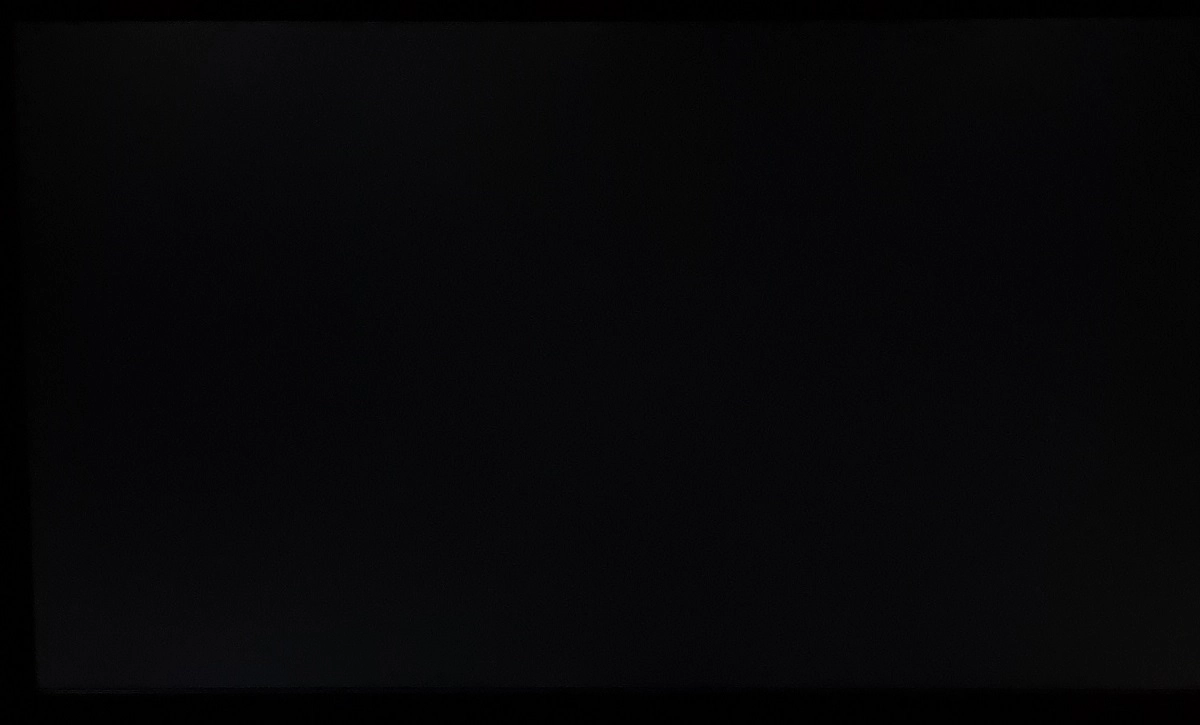
The SpyderX Elite was used to assess the uniformity of lighter shades, represented by 9 equally spaced white quadrants running from the top left to bottom right of the screen. The table below shows the luminance recorded at each quadrant as well as the percentage deviation between each quadrant and the brightest recorded point.

Luminance uniformity table
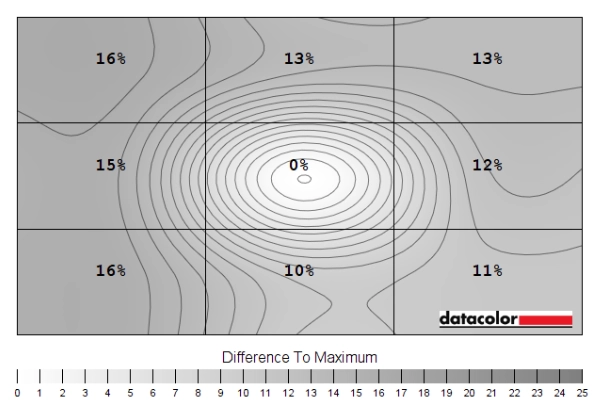
Luminance uniformity map
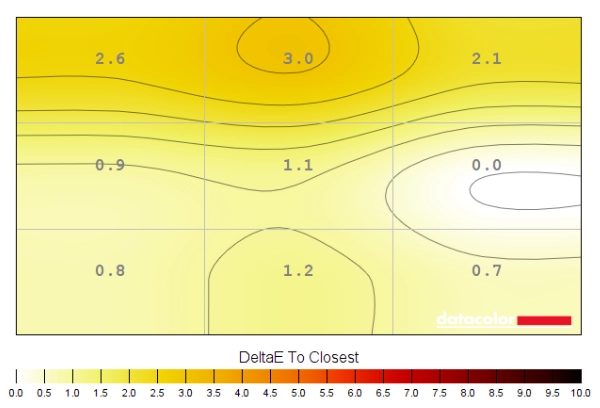
Colour temperature uniformity map
Contrast in games and movies
Lagom contrast tests
Colour reproduction
Colour gamut
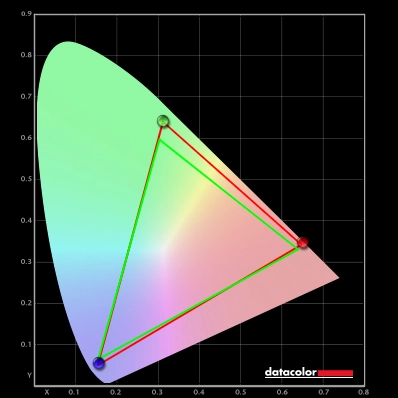
Colour gamut 'Test Settings'
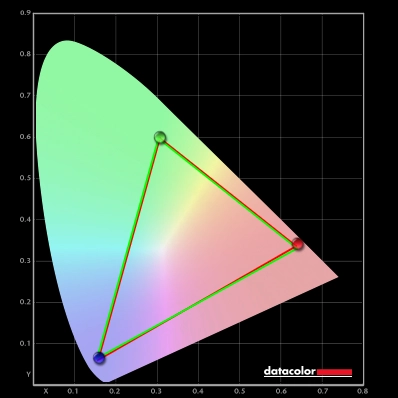
Colour gamut 'sRGB'

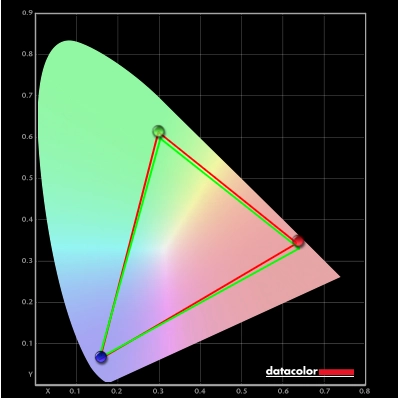
Colour gamut AMD 'CTC disabled' setting
Colour in games and movies
Shade representation using SpyderCHECKR 24
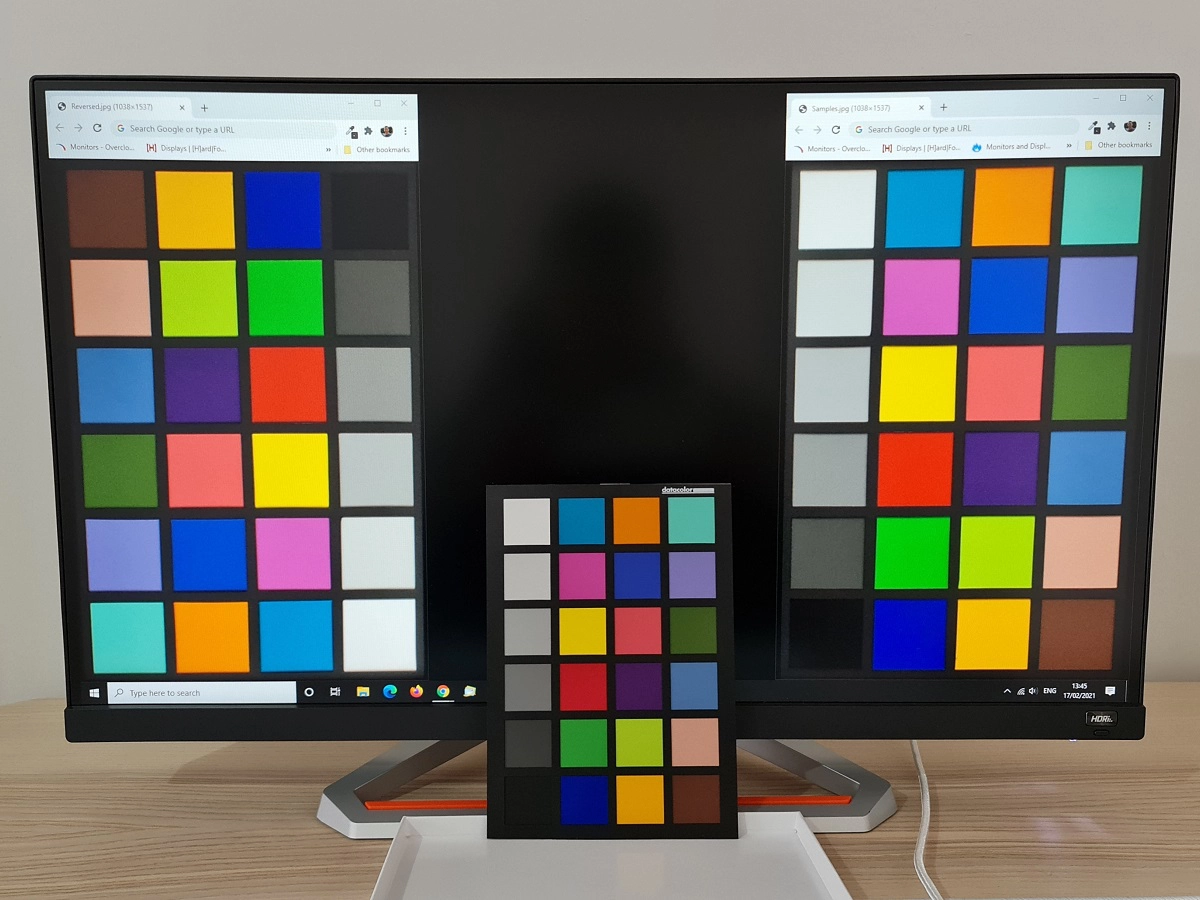
The monitor reproduced most shades faithfully here. Gamboge (23) appeared a touch too yellow without quite enough of a rich golden quality to it. Some green-biased shades such as dark lime green (18) and yellow green (19) appeared just a touch towards the neon end, whilst candy apple red (14) appeared just a touch too vivid and warm with a bit of an orange-red quality to it. This is due to a bit of extension beyond sRGB in the gamut for green and in the yellow-red region. But this was not strong oversaturation and the representation of these and indeed other shades was more appropriate than they would be on an unprofiled wide gamut monitor. The monitor shows strong consistency as well, without strong deviations when comparing the two on-screen shade sets. Some deviations can occur due to uniformity issues rather than viewing angle related issues. Things certainly appear more consistent than the VA and moreover TN references shown in our panel types article. The image below shows show things appear using the sRGB emulation setting (‘Color Mode = sRGB’) and factory default colour channel settings.
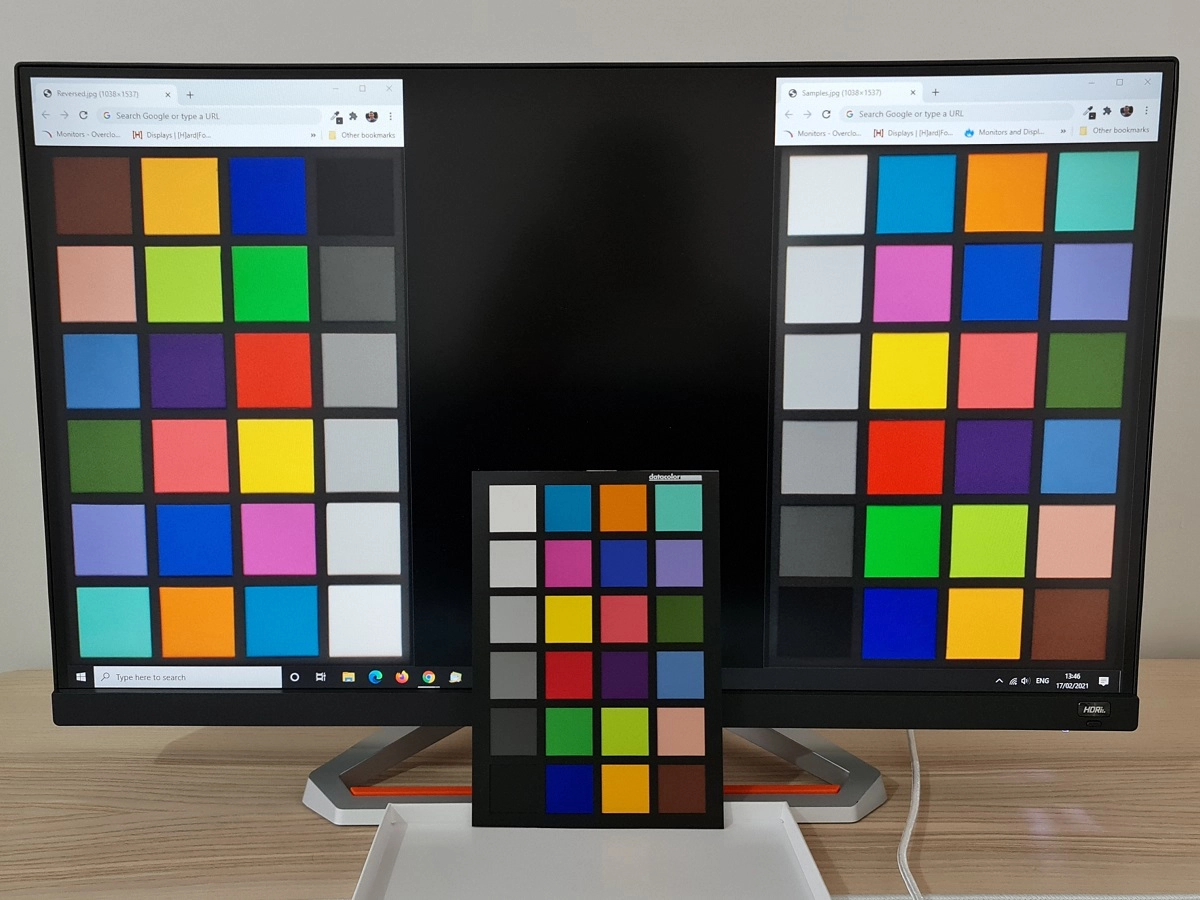
The differences here only slight, which is not entirely unexpected given that the gamut doesn’t extent massively beyond sRGB to begin with. Some shades appear a bit more muted, including the shades we said appeared just slightly overdone before. Aquamarine (4) now verges a touch too much on aqua, although this is a subtle difference which isn’t captured clearly in the photograph. As usual, we’d recommend profiling the monitor with your own colorimeter or alternative calibrator using the native gamut if you require the highest level of colour accuracy.
Viewing angles
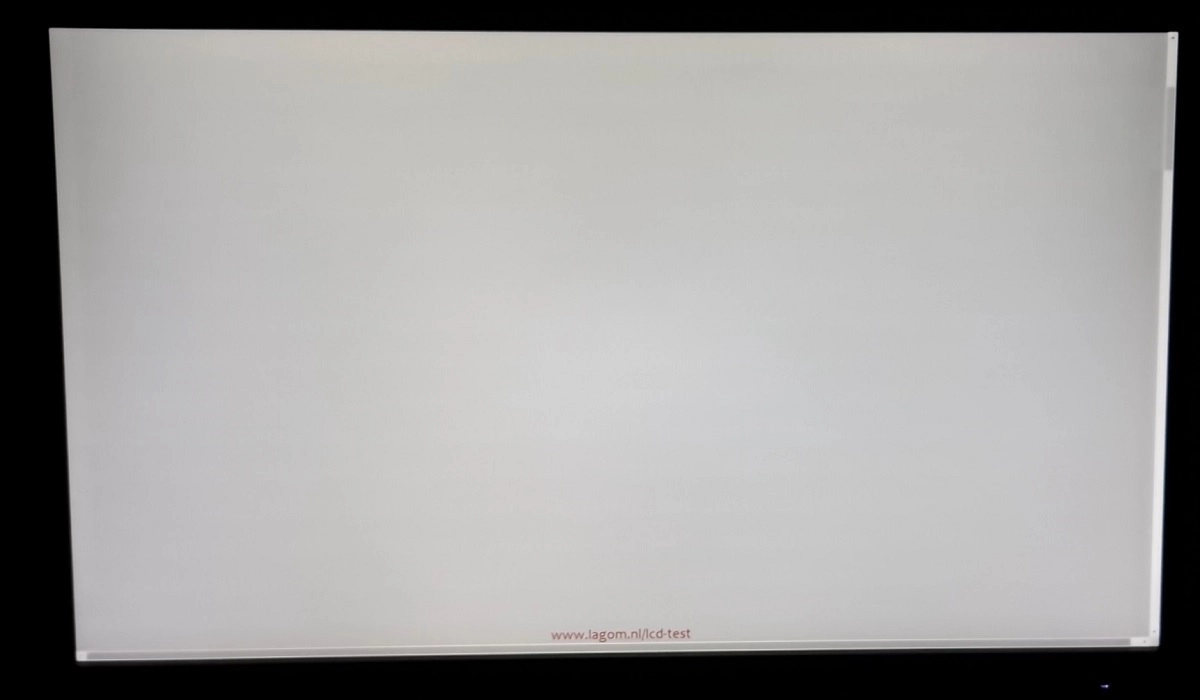
The video below shows the Lagom text test, a mixed desktop background, game scene and dark desktop background from a variety of viewing angles. You can see fairly minor colour shifts for the mixed desktop background and game scene. Certainly less pronounced than you’d see on TN or VA models. There’s a horizontal ‘hazing’ (contrast loss) at moderate to sharper viewing angles that’s slightly more pronounced than on some IPS-type models. The dark desktop background highlights ‘IPS glow’, which creates an obvious ‘bloom’ as viewing angles sharpen. Depending on angle, the glow may take on a cooler appearance or slightly warm grey shade.
Interlace pattern artifacts
Responsiveness
Input lag
Perceived blur (pursuit photography)
Note that wavy patterns surrounding some UFOs in the background are slight image retention. This was only observed during this test and is something we’ve seen on various monitors before. It soon disappeared when using monitor normally.
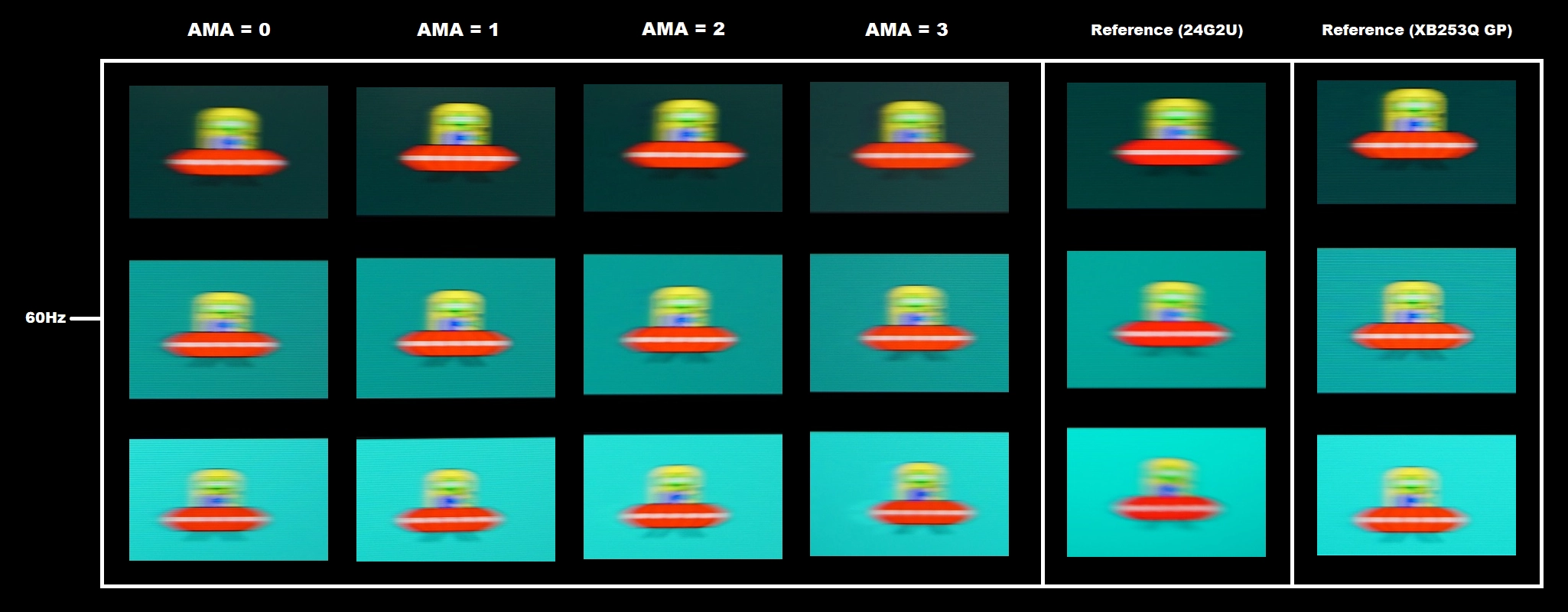
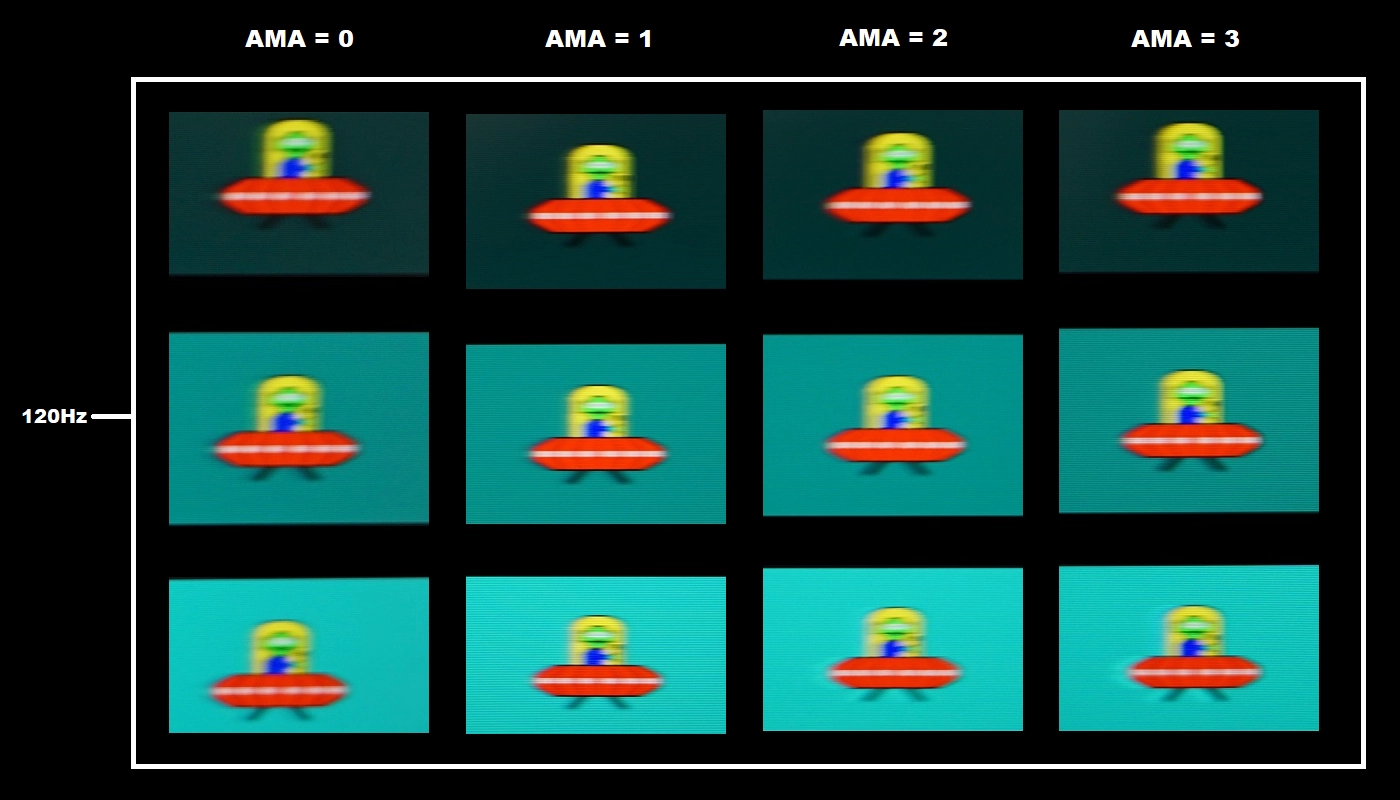

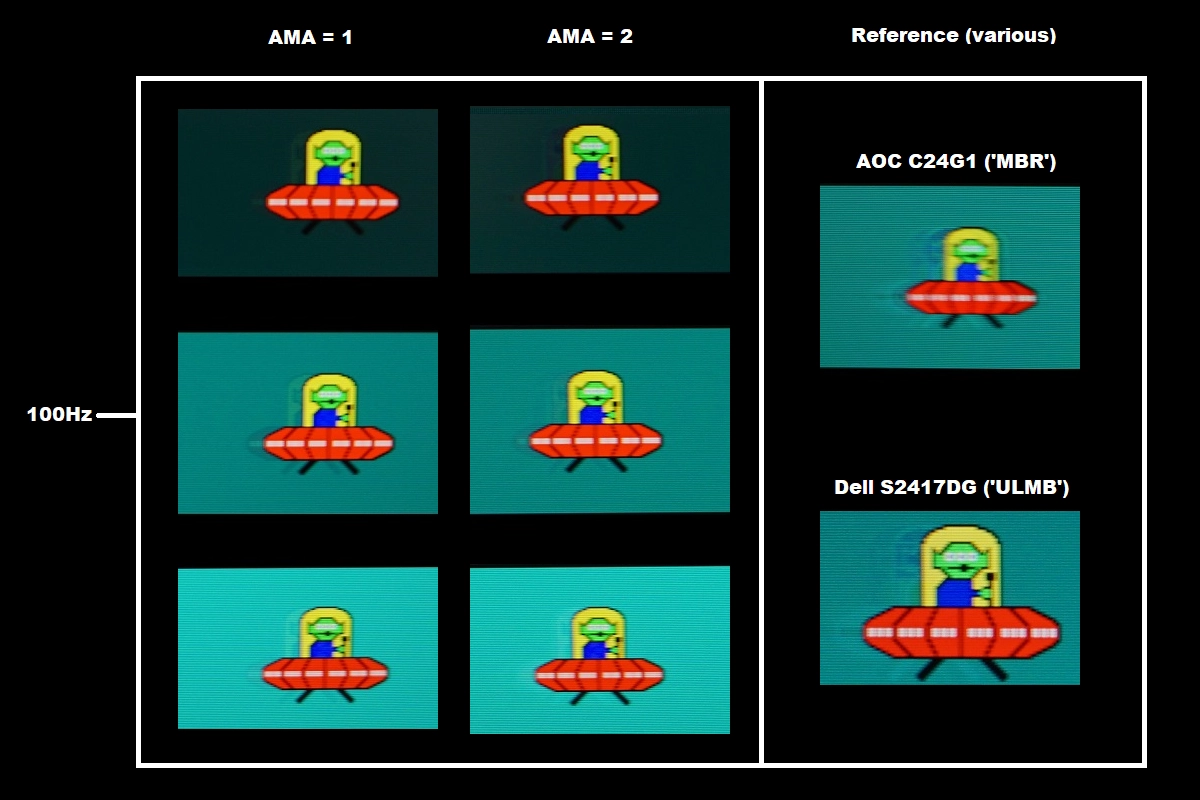
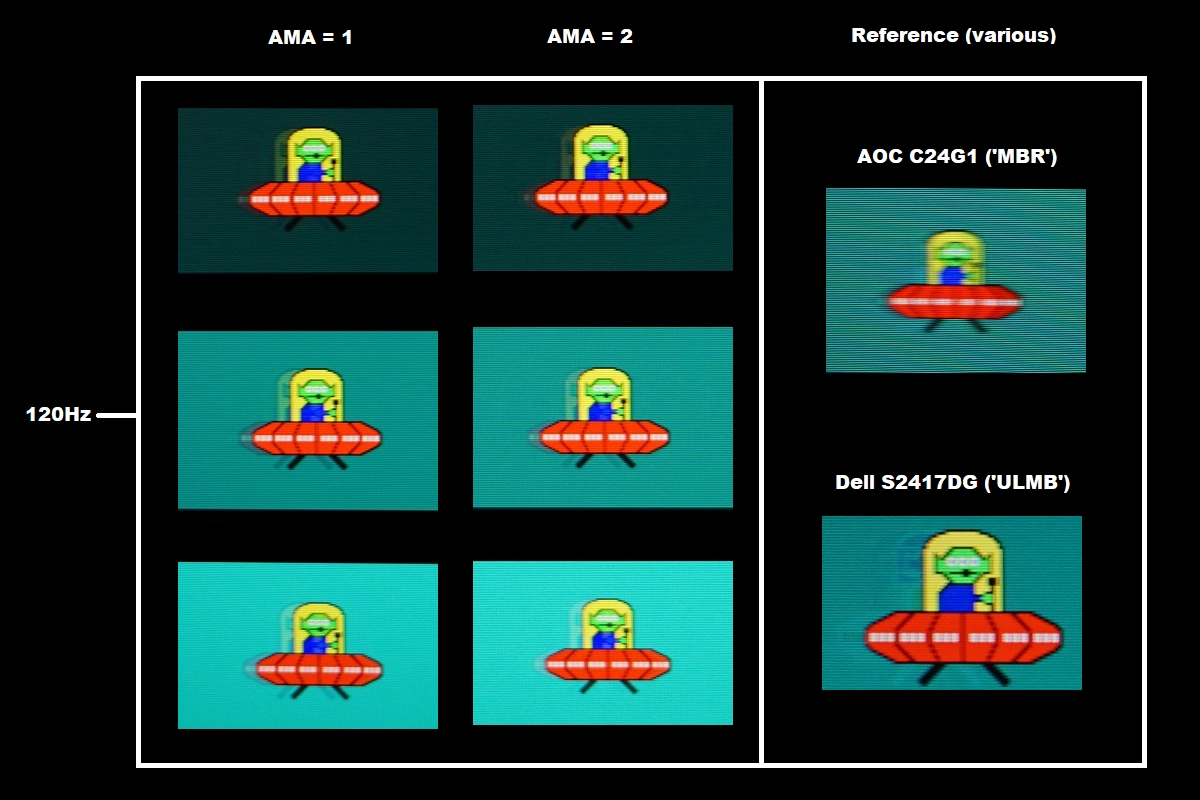
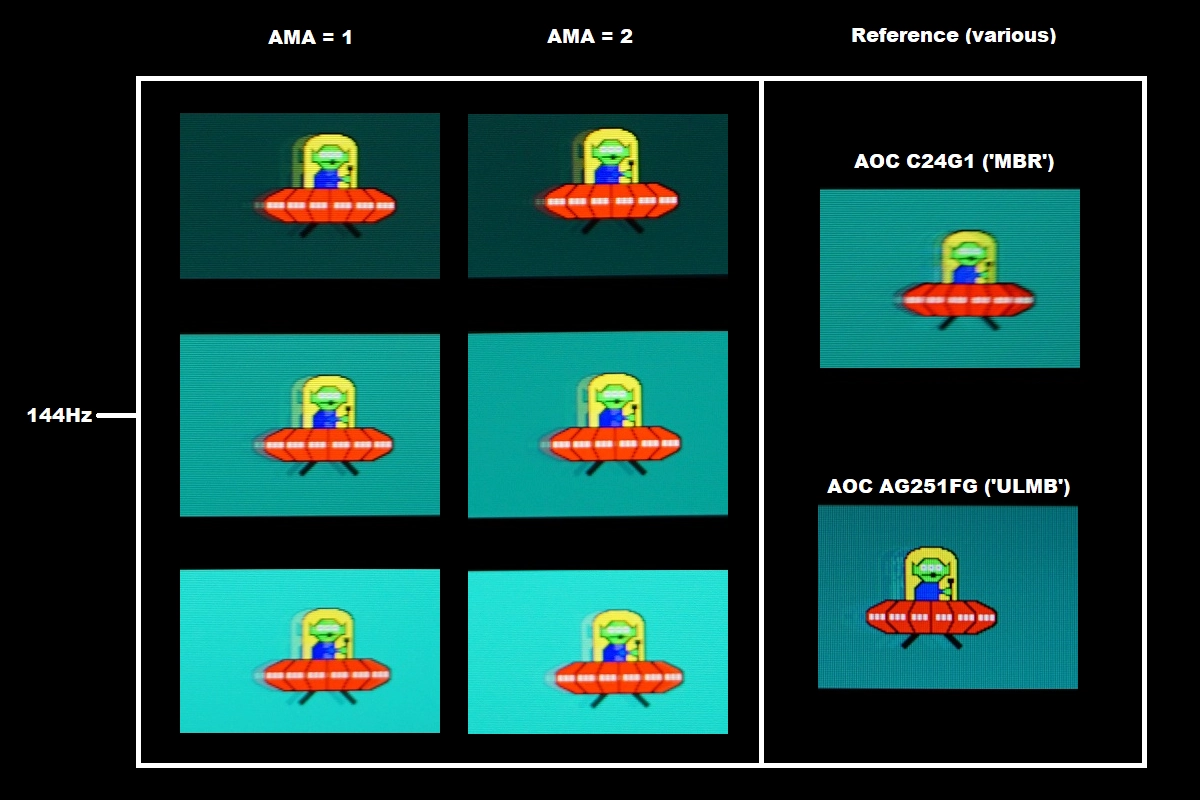
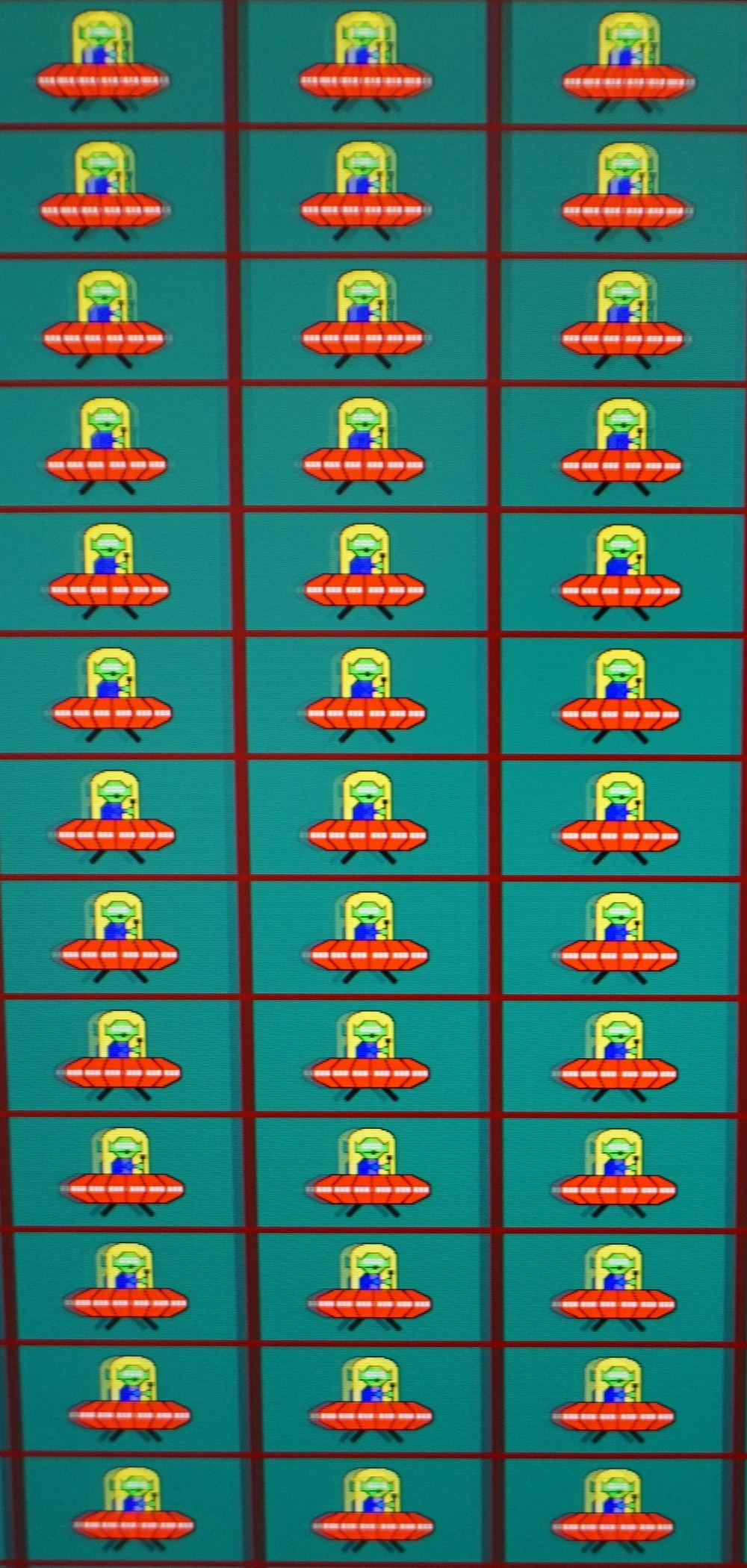
Responsiveness in games and movies

Blur Reduction
VRR (Variable Refresh Rate) technology
FreeSync – the technology and activating it
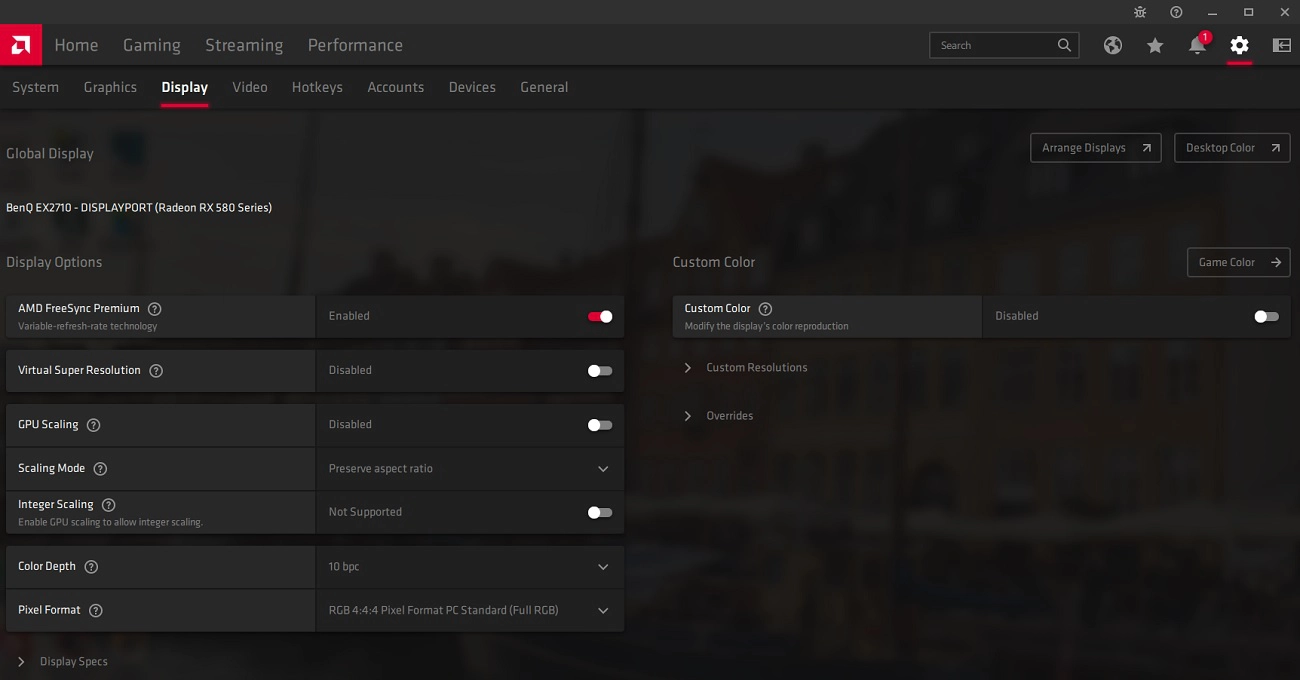
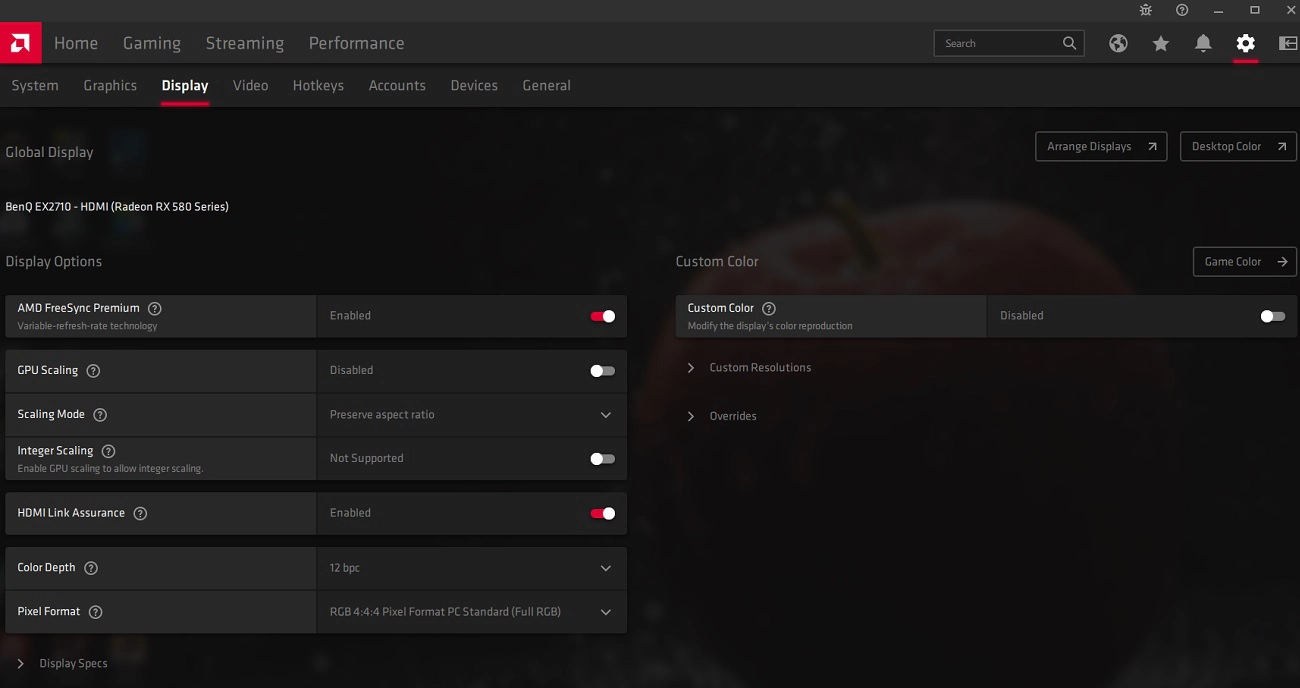
The BenQ supports a variable refresh rate range of 48 – 144Hz. That means that if the game is running between 48fps and 144fps, the monitor will adjust its refresh rate to match. When the frame rate rises above 144fps, the monitor will stay at 144Hz and the GPU will respect your selection of ‘VSync on’ or ‘VSync off’ in the graphics driver. With ‘VSync on’ the frame rate will not be allowed to rise above 144fps, at which point VSync activates and imposes the usual associated latency penalty. With ‘VSync off’ the frame rate is free to climb as high as the GPU will output (potentially >144fps). AMD LFC (Low Framerate Compensation) is also supported by this model, which means that the refresh rate will stick to multiples of the frame rate where it falls below the 48Hz (48fps) floor of operation for FreeSync. If a game ran at 33fps, for example, the refresh rate would be 66Hz to help keep tearing and stuttering at bay. This feature is used regardless of VSync setting, so it’s only above the ceiling of operation where the VSync setting makes a difference.

Some users prefer to leave VSync enabled but use a frame rate limiter set a few frames below the maximum supported (e.g. 141fps) instead, avoiding any VSync latency penalty at frame rates near the ceiling of operation or tearing from frame rates rising above the refresh rate. Curiously the refresh rate displayed in the OSD only reflected the static refresh rate and didn’t match the refresh rate in a VRR environment using FreeSync. And ‘FreeSync Premium: ON’ was displayed even if the setting was deactivated in the graphics driver. This contrasted with our Nvidia GPU which reported the refresh rate in the VRR environment and only displayed ‘FreeSync Premium: ON’ if ‘G-SYNC Compatible Mode’ was enabled in the driver. This didn’t affect the operation of the technology, but means you couldn’t confirm in the OSD whether it was actively being used or not.
FreeSync – the experience
Nvidia Adaptive-Sync (‘G-SYNC Compatible’)
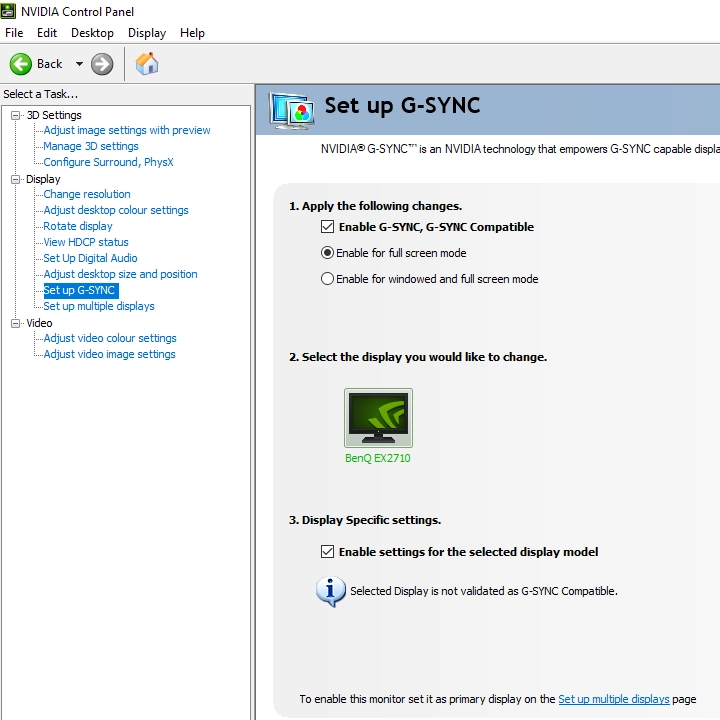
You will also see in the image above that it states: “Selected Display is not validated as G-SYNC Compatible.” This means Nvidia hasn’t specifically tested and validated the display. On our RTX 3090, the experience was very similar to what we described with FreeSync. Surprisingly, the floor of operation for VRR was lowered to 38Hz – below that an LFC-like frame to refresh multiplication was used to keep tearing and stuttering at bay. Whilst there was momentary stuttering when this boundary was crossed, it was masked very effectively by the ‘low frame rate judder’ that is experienced at such a low frame rate anyway.
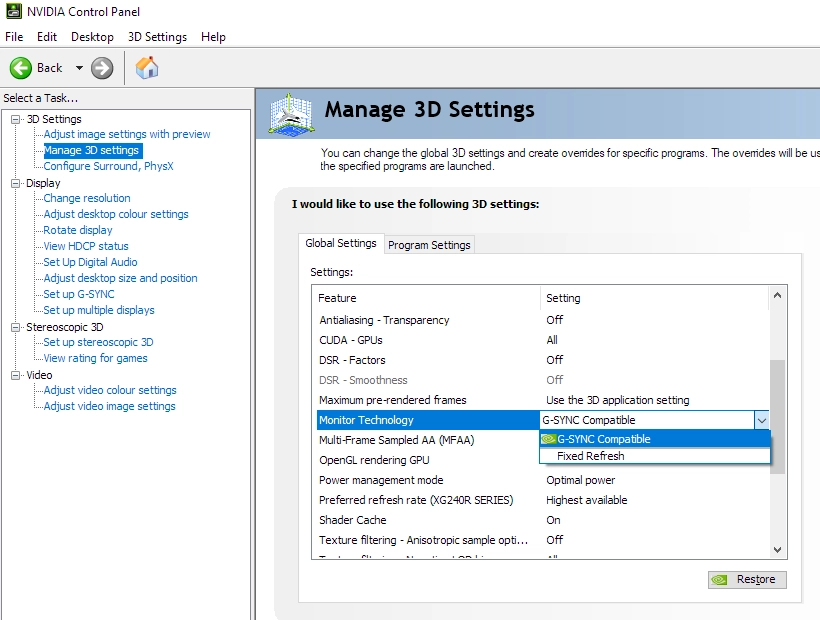
Finally, note that the refresh rate displayed in the OSD reflected the frame rate of the content when it was within the main VRR window (38 – 144Hz), updated when you first enter the section of the OSD where it’s displayed. And as with AMD FreeSync, HDR can be used at the same time as ‘G-SYNC Compatible Mode’.
HDR (High Dynamic Range)
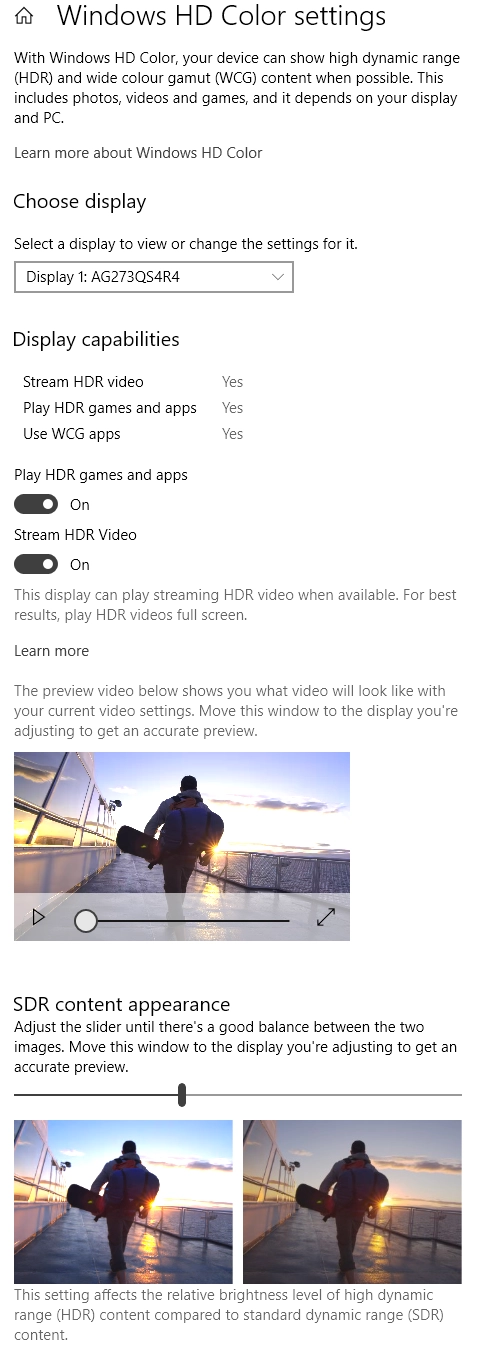
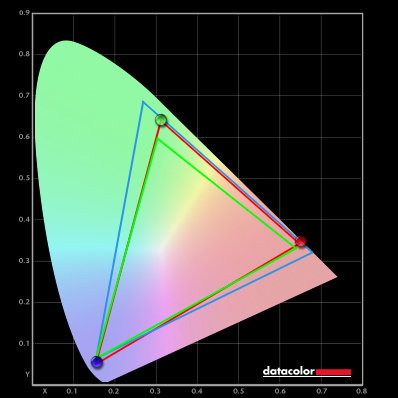
Colour gamut 'Test Settings'
The HDR10 pipeline makes use of 10-bits per colour channel, which the monitor supports via 8-bit + FRC. The enhanced precision of the 10-bit signal enhances the nuanced shade variety. For darker shades, it provides a natural uplift to detail in a way that’s far more natural than could be achieved using gamma enhancements under SDR. The superior range of closely matching shades helped smooth out gradients for brighter shades as well, with more natural progressions for weather effects, smoke and rays of light. The image below shows one of our favourite scenes under Shadow of the Tomb Raider for highlighting a strong HDR performance. Note that the photo is purely for illustrative purposes and in no way represents how the monitor appeared running HDR in person.
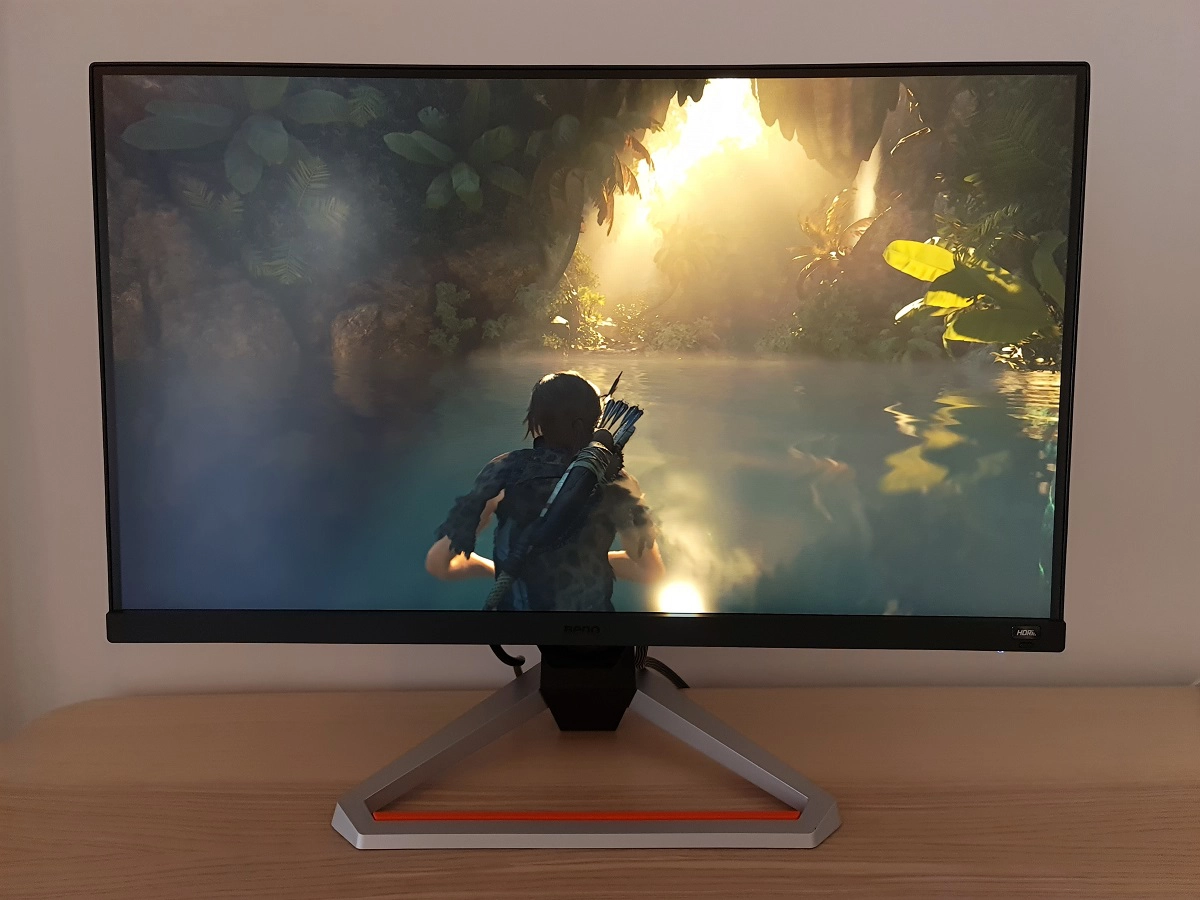
Video review
Timestamps:
Features & Aesthetics
Contrast
Colour reproduction
HDR (High Dynamic Range)
Responsiveness (General)
Responsiveness (Adaptive-Sync)
Conclusion
Positives Negatives A rich and natural look to things with good sRGB coverage and a bit beyond, plus strong consistency from the IPS-type panel
Gamma tracking not quite at ‘2.2’ target on our unit, no support for extended colour spaces and very basic HDR support Decent static contrast for an IPS-type panel, whilst the light and relatively smooth screen surface kept the image free from obvious layering or graininess Moderate ‘IPS glow’ ate away at detail and atmosphere, especially in dimmer conditions A respectable 144Hz performance with good overall pixel responsiveness, a good Adaptive-Sync implementation and a decent strobe backlight setting that some will find useful Minor pixel response time weaknesses in places, including a touch of overshoot using our preferred setting that become stronger (but still not ‘extreme’) at reduced refresh rates Good ergonomic flexibility, a feature-rich OSD with some useful additions and appropriate pricing in many regions Distinctive ‘MOBIUZ strip’ on stand won’t be to everyone’s taste, no pivot with included stand. A restrictive resolution and fairly low pixel density


